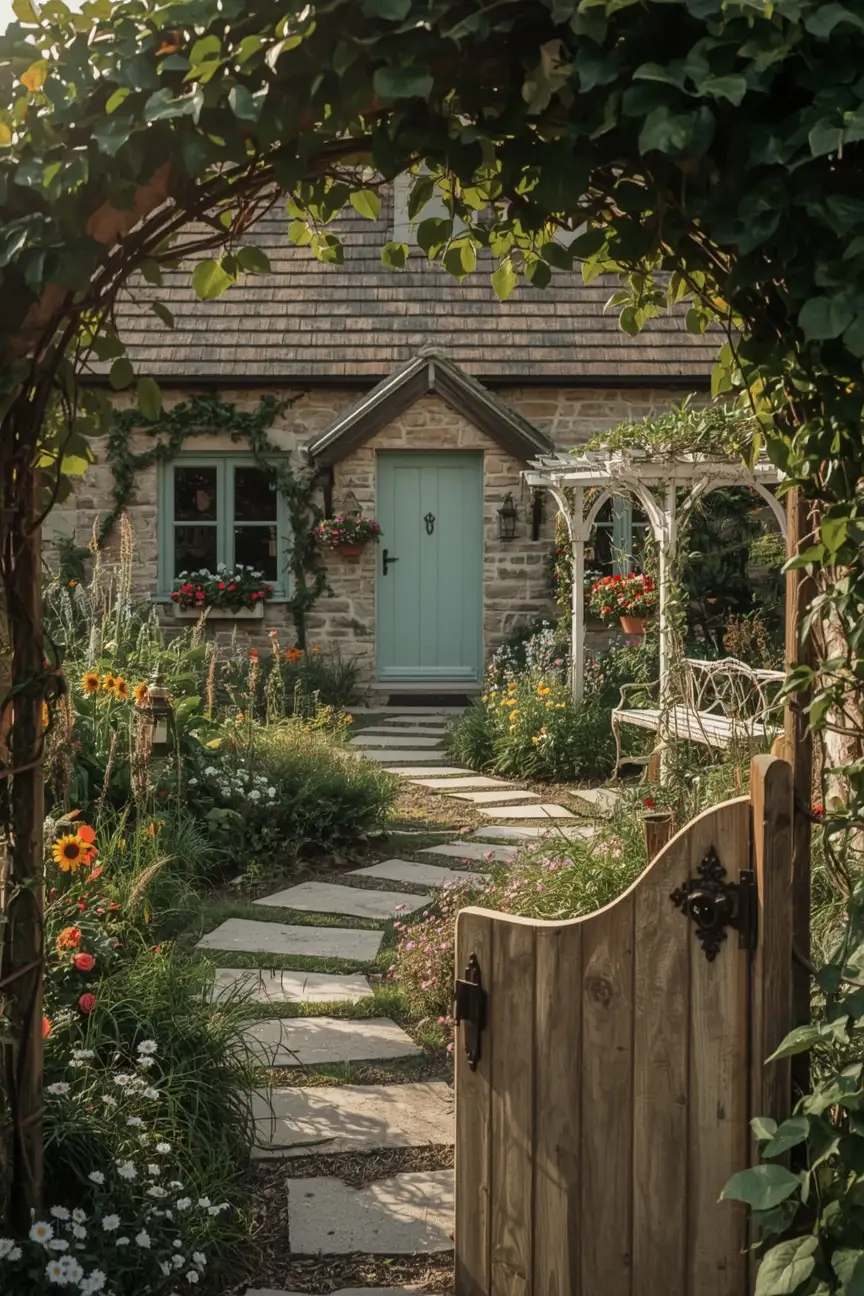Small cottage garden ideas have completely transformed how I think about outdoor spaces. After years of struggling with my tiny backyard, I discovered that size doesn’t matter when it comes to creating a magical garden retreat. The cottage garden style embraces abundance within boundaries, mixing flowers, herbs, and vegetables in delightful chaos that feels both wild and intentional.
I’ve spent countless hours researching, experimenting, and talking with fellow gardeners to compile these 45 inspiring ideas. Each approach works beautifully in compact spaces while maintaining that quintessential cottage charm we all love. From clever vertical solutions to plant combinations that thrive together, these concepts will help you maximize every square inch of your outdoor area.
The beauty of cottage gardening lies in its forgiving nature and timeless appeal. You don’t need perfect soil, expensive materials, or years of experience to create something wonderful. What you need is enthusiasm, creativity, and willingness to let your garden evolve naturally over time.
1. Layered Flower Border Magic
Creating depth in a small cottage garden starts with mastering the art of layered planting. I arrange my flowers in three distinct tiers: tall backdrop plants like hollyhocks and delphiniums against fences or walls, medium-height beauties such as roses and lavender in the middle, and low-growing gems like sweet alyssum and lobelia at the front.
This technique creates visual interest while making your space appear larger than it actually is. The key lies in choosing plants with different bloom times, ensuring continuous color throughout the growing season. I mix annuals with perennials, combining the reliable return of established plants with the exciting possibilities of seasonal varieties.
Consider plant textures alongside colors when planning your layers. Feathery astilbe contrasts beautifully with broad hosta leaves, while spiky salvia creates drama next to rounded geraniums. This interplay of forms adds sophistication to the cottage garden’s naturally relaxed style.
Remember to leave space between plantings for growth and air circulation. Dense planting looks lush but can lead to disease problems and competition for nutrients. I learned this lesson after losing several prized plants to overcrowding in my early gardening days.
2. Vintage Container Gardens
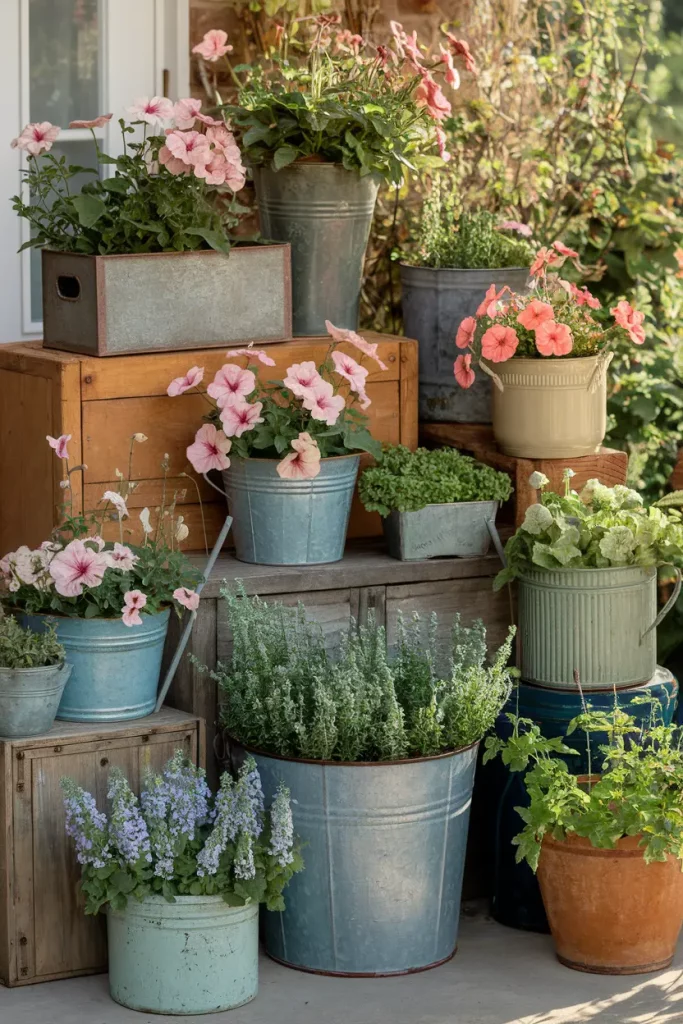
Old-fashioned containers bring instant cottage charm to any small space. I collect weathered wooden boxes, galvanized buckets, ceramic crocks, and vintage enamelware throughout the year, transforming them into portable garden features that can move with the seasons.
Drainage remains crucial for container success, regardless of how charming your vessel looks. I drill holes in the bottom of non-porous containers and add a layer of gravel or broken pottery shards before adding soil. This prevents root rot while maintaining the vintage aesthetic that makes these containers special.
Group containers of varying heights and sizes for maximum impact. I place taller pots in back with shorter ones cascading forward, creating natural-looking arrangements that feel intentional rather than scattered. Odd numbers work better than even groupings, and mixing materials adds visual texture.
Fill your vintage containers with cottage garden classics like trailing petunias, upright snapdragons, and cascading nasturtiums. These plants thrive in confined spaces while providing the abundant, slightly wild look that defines cottage style. Don’t forget to include some herbs like thyme or oregano for practical beauty.
3. Picket Fence Border Beauty
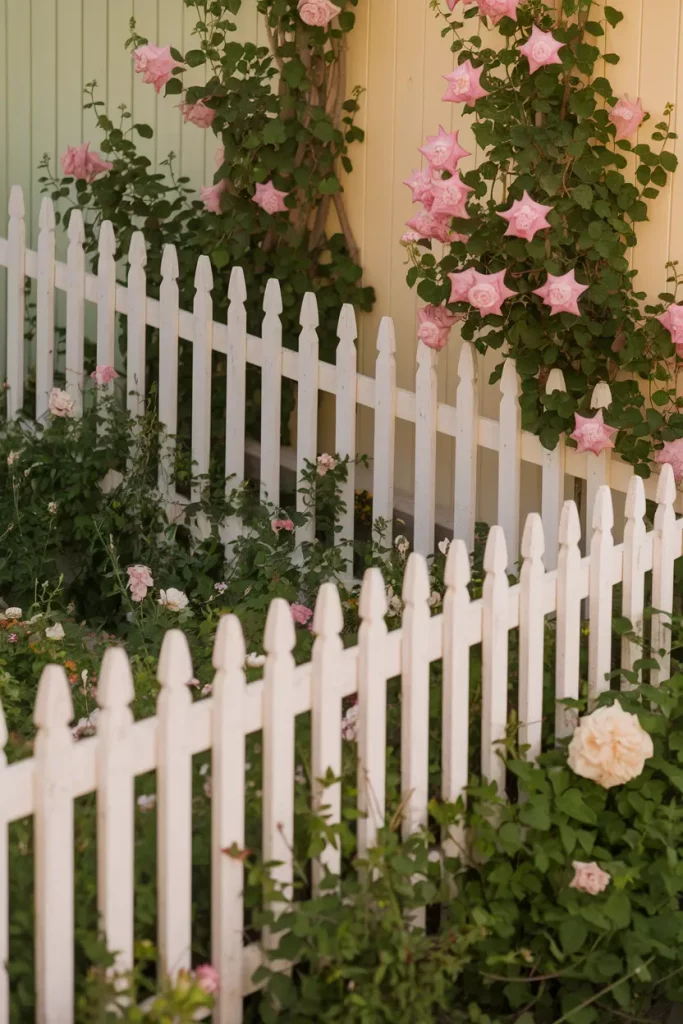
A white picket fence creates the perfect cottage garden backdrop while defining boundaries in small spaces. I use mine as both decorative element and practical support structure for climbing plants and tall flowers that need extra stability.
The fence doesn’t need to surround your entire garden to be effective. Even a short section creates focal point and establishes cottage style instantly. I painted mine with traditional white picket fence paint, but soft pastels like sage green or cream work beautifully too, especially if they complement your home’s exterior colors.
Plant climbing roses, clematis, or morning glories to scramble up and through the picket slats. These vertical growers add height without taking up precious ground space, while their flowers create stunning displays against the fence backdrop. I train them gently with soft ties, allowing for natural growth patterns.
Use the fence as anchor point for garden rooms within your small space. Different sections can serve different purposes: herbs near the kitchen, cutting flowers by a seating area, or vegetables tucked discretely behind taller ornamental plants.
Recommended: 40 Stunning Modern Farmhouse Living Room Ideas for a Cozy Retreat
4. Herb Spiral Garden Design
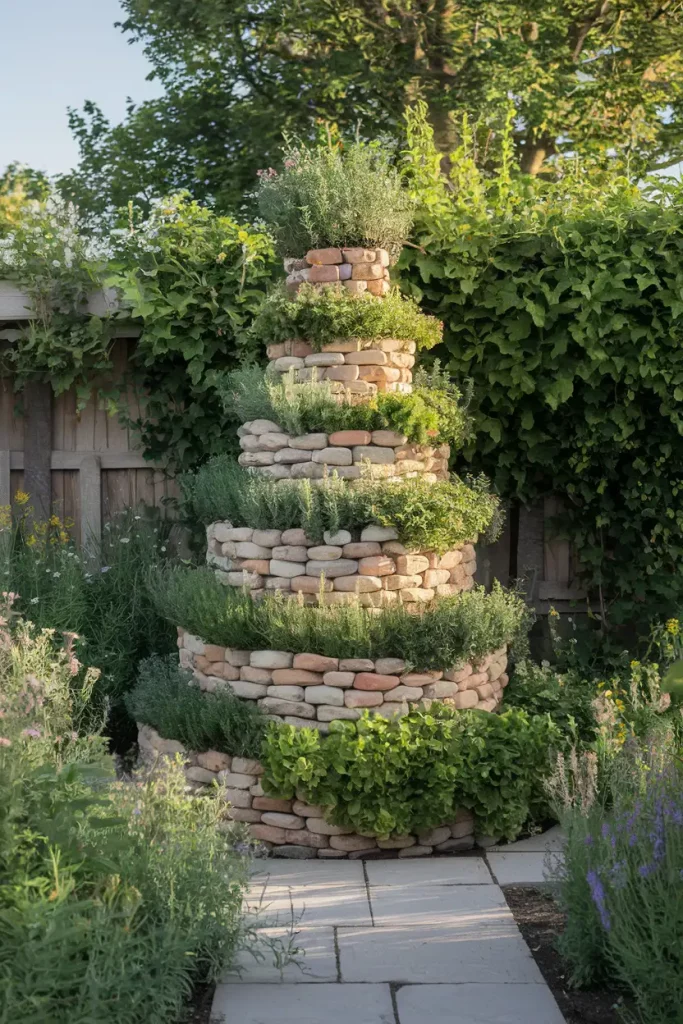
A herb spiral maximizes growing space while creating an attractive focal point in small cottage gardens. This permaculture technique uses a spiral mound to create different microclimates and growing conditions within a compact footprint, perfect for growing various herbs with different needs.
I built mine using natural stones, creating a spiral that rises from ground level to about three feet at the center. The varying heights and aspects provide sunny, dry conditions at the top for Mediterranean herbs like rosemary and thyme, while the bottom offers moister conditions perfect for parsley and chives.
Construction requires planning but uses simple materials. I started with a circle about six feet across, then created the spiral pathway using stones or bricks. Fill with good quality soil, adding extra drainage material like sand or gravel to the upper levels where drought-tolerant herbs will live.
Plant strategically according to each herb’s needs and growth habits. Tall herbs like rosemary and sage go toward the center top, medium-height plants like oregano and basil fill the middle sections, and spreading herbs like thyme cascade down the outer edges. This creates a living sculpture that’s both beautiful and productive.
5. Window Box Cottage Charm
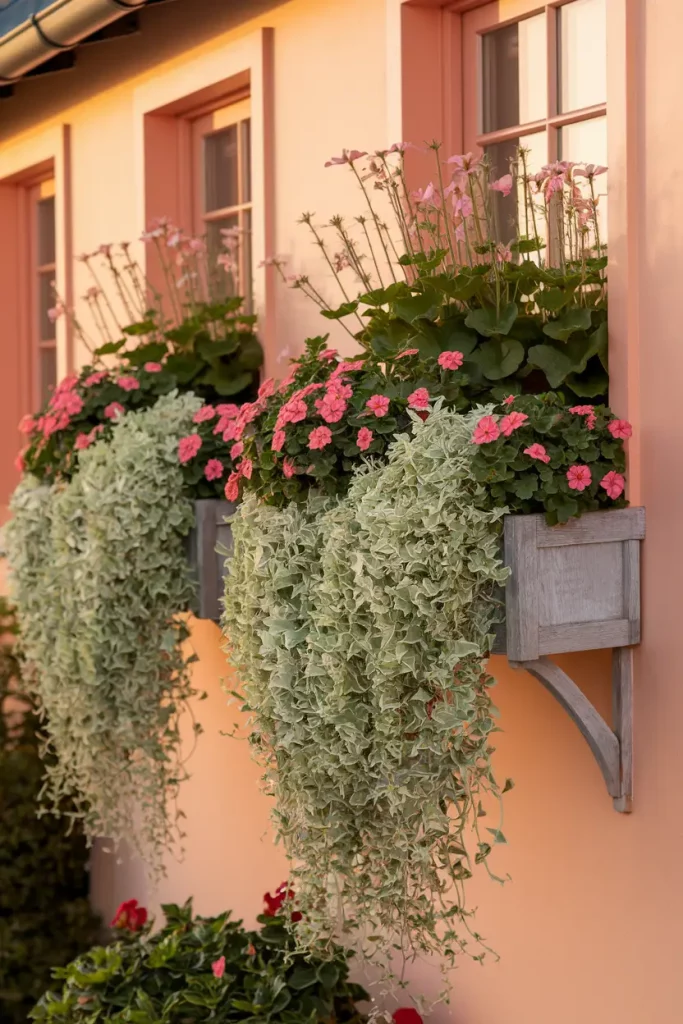
Window boxes bring cottage garden beauty right up to your home’s windows, creating delightful views from inside while adding architectural interest to the exterior. I use them extensively in my small garden design, treating them as extensions of the larger garden rather than separate decorative elements.
Choose boxes that complement your home’s style while providing adequate growing space. I prefer wooden boxes with good drainage, but fiberglass and metal options work well too. Size matters more than material – boxes should be at least eight inches deep and twelve inches wide to support healthy plant growth.
Fill window boxes with a mix of upright and trailing plants for best visual impact. I combine upright flowers like geraniums or petunias with cascading varieties such as ivy geraniums, bacopa, or trailing lobelia. This creates full, abundant displays that look generous and cottage-like rather than sparse or formal.
Maintain window boxes with regular watering and feeding since container plants dry out faster than ground plantings. I check mine daily during hot weather and feed weekly with diluted liquid fertilizer to keep blooms coming all season long.
6. Cottage Garden Path Design
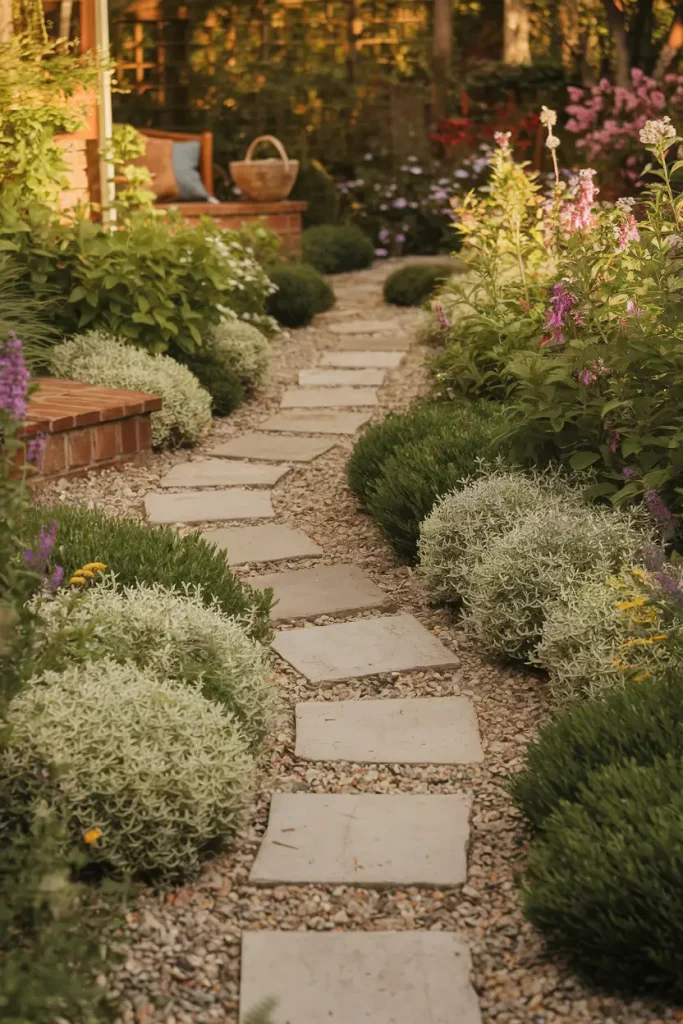
Meandering paths add mystery and romance to small cottage gardens while providing practical access to different areas. I design mine to curve gently rather than run in straight lines, creating the illusion of more space while encouraging visitors to slow down and notice garden details.
Natural materials work best for cottage garden paths. I use combinations of flagstone, brick, gravel, and stepping stones to create surfaces that feel established and comfortable. Reclaimed materials add character and history that new products simply cannot match.
Allow plants to spill onto path edges for that authentic cottage garden look. I encourage low-growing perennials like lamb’s ear, lady’s mantle, and creeping thyme to soften hard edges and create the slightly overgrown appearance that makes cottage gardens so appealing.
Width matters less than proportion in small spaces. I make my main paths wide enough for comfortable walking (about three feet) but create narrower side paths (eighteen inches) that lead to special garden features or quiet seating spots. This hierarchy helps organize the space without making it feel cramped.
7. Climbing Rose Archway
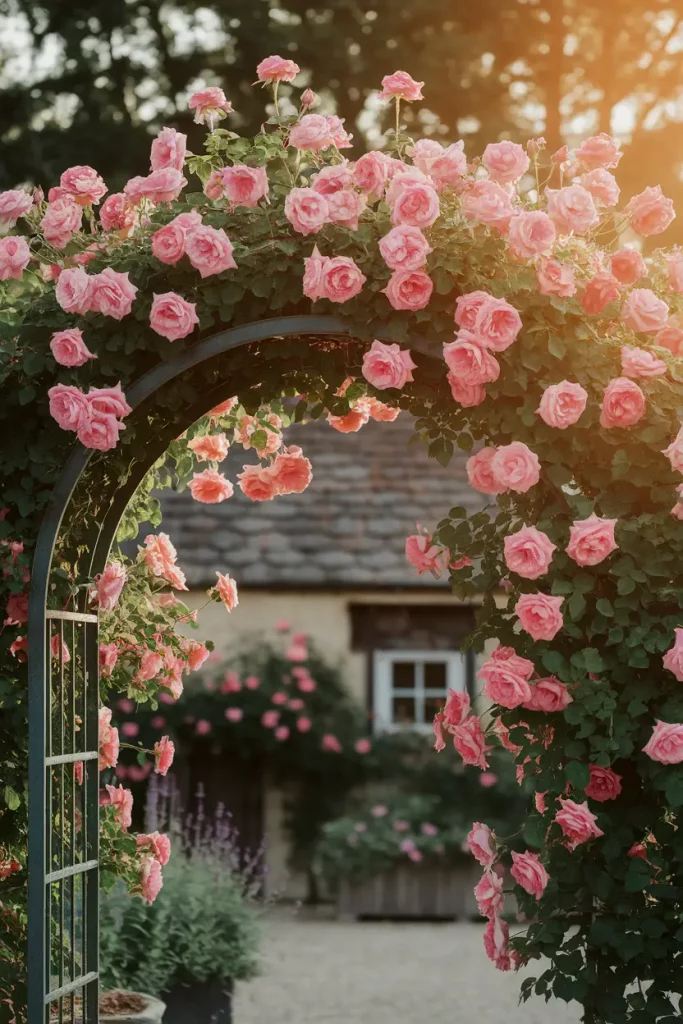
A rose-covered archway creates instant romance and vertical interest in small cottage gardens. I position mine to frame views, mark transitions between garden areas, or simply provide a stunning focal point that draws the eye upward and makes the space feel larger.
Choose climbing roses suited to your climate and space constraints. I prefer repeat-blooming varieties like ‘Eden’, ‘New Dawn’, or ‘William Baffin’ that provide color throughout the growing season rather than single spectacular displays. Fragrant varieties add another sensory dimension to the garden experience.
Build or buy an archway sturdy enough to support mature rose growth. Roses become heavy over time, and wind can create significant stress on support structures. I use metal archways anchored securely in the ground, though wooden structures work well if properly constructed and maintained.
Train roses carefully during their first few years to establish good coverage and flowering. I tie new growth to the arch framework using soft materials that won’t cut into stems. Horizontal training encourages more blooms than vertical growth, creating fuller, more spectacular displays.
8. Mixed Vegetable and Flower Beds
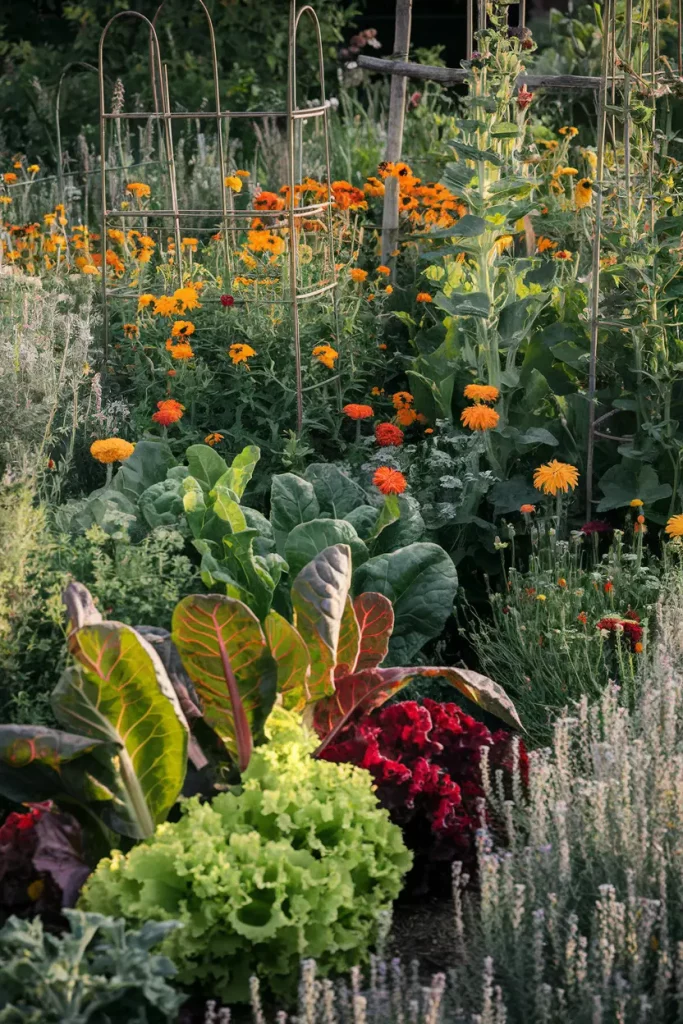
Combining vegetables with flowers creates productive cottage garden beds that are both beautiful and practical. I interplant ornamental and edible plants throughout my garden, following the traditional cottage approach where every plant earns its place through beauty, usefulness, or both.
Choose vegetables that contribute to garden aesthetics as well as the dinner table. Colorful Swiss chard, purple cabbage, frilly lettuce varieties, and climbing beans on decorative supports all provide visual interest while producing food. I tuck these among flowers rather than segregating them in separate vegetable plots.
Plan combinations that benefit each other through companion planting principles. I grow nasturtiums among my tomatoes to deter pests, plant basil near peppers for improved flavor, and use marigolds throughout the garden for their pest-repelling properties. These partnerships create healthier, more productive gardens.
Succession plant vegetables to maintain continuous harvests and garden beauty. Rather than planting entire rows at once, I sow small amounts every few weeks, ensuring fresh crops and preventing gaps in the garden design when plants are harvested.
9. Cottage Garden Water Feature
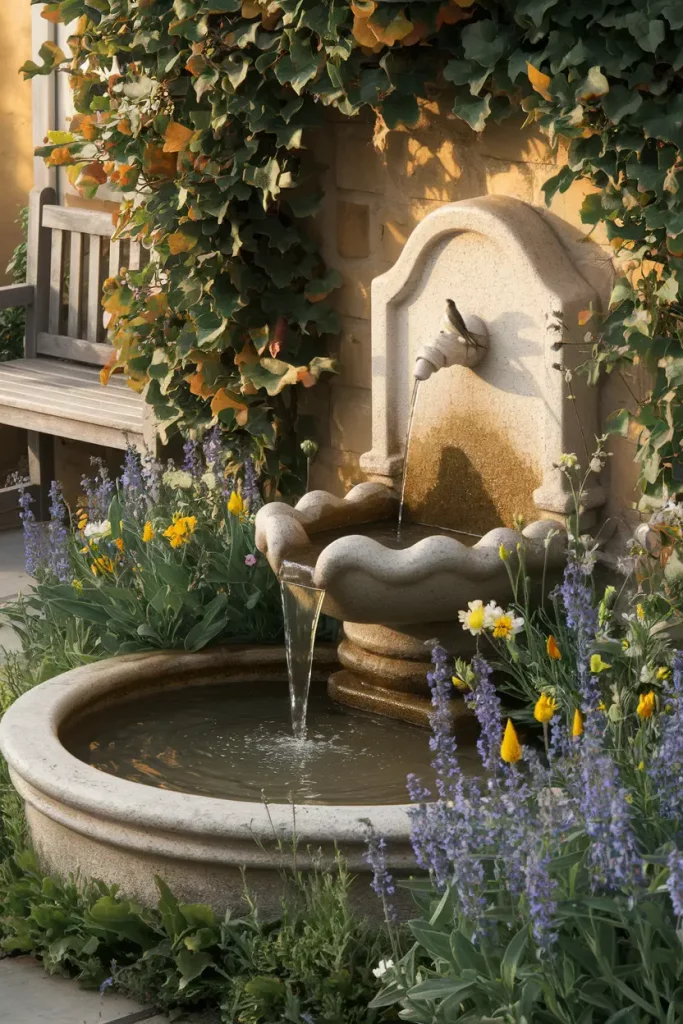
Small water features add tranquility and attract beneficial wildlife to cottage gardens. I incorporate simple elements like small fountains, shallow bird baths, or container water gardens that provide the sound and movement of water without requiring major installation or maintenance.
Position water features where you can enjoy them from both inside and outside your home. I place mine near seating areas or along paths where visitors will encounter them naturally. The sound of moving water helps mask urban noise while creating peaceful garden atmosphere.
Choose styles that complement cottage garden aesthetics rather than formal contemporary designs. I prefer weathered stone, aged metal, or ceramic pieces that look like they’ve been in the garden for years. Patina and moss growth only improve their appearance over time.
Maintain water features regularly to keep them healthy and attractive. I clean filters, remove debris, and refresh water weekly during growing season. Adding aquatic plants like water lilies or floating hearts creates natural balance while reducing maintenance needs.
See also: 25 Low-Cost Ways to Landscape a Side Yard
10. Seasonal Color Succession
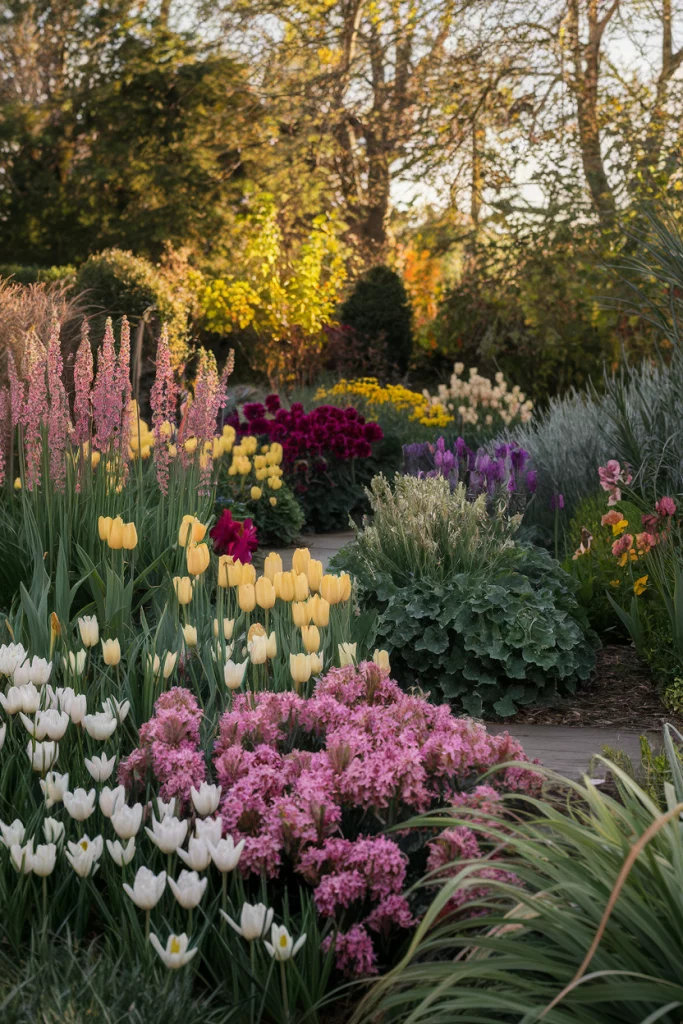
Planning for continuous color throughout the growing season requires careful plant selection and strategic placement. I choose combinations that provide interest from early spring through late fall, ensuring my small cottage garden never looks bare or uninteresting.
Start with early bulbs like crocuses, daffodils, and tulips for spring color before perennials emerge. I plant these among later-growing plants where their dying foliage will be hidden by new growth. This layered approach maximizes space while providing seamless seasonal transitions.
Include plants with different bloom times within each garden area. I combine early, mid, and late-season flowers in every bed, ensuring something is always in bloom. This requires research and record-keeping, but the results justify the effort with gardens that provide consistent beauty.
Don’t forget about foliage plants that provide color and texture when flowers aren’t blooming. I use plants with colorful or interesting leaves like heuchera, coleus, and ornamental grasses to bridge gaps between flowering periods and add structural elements to the design.
11. Cottage Garden Seating Nook
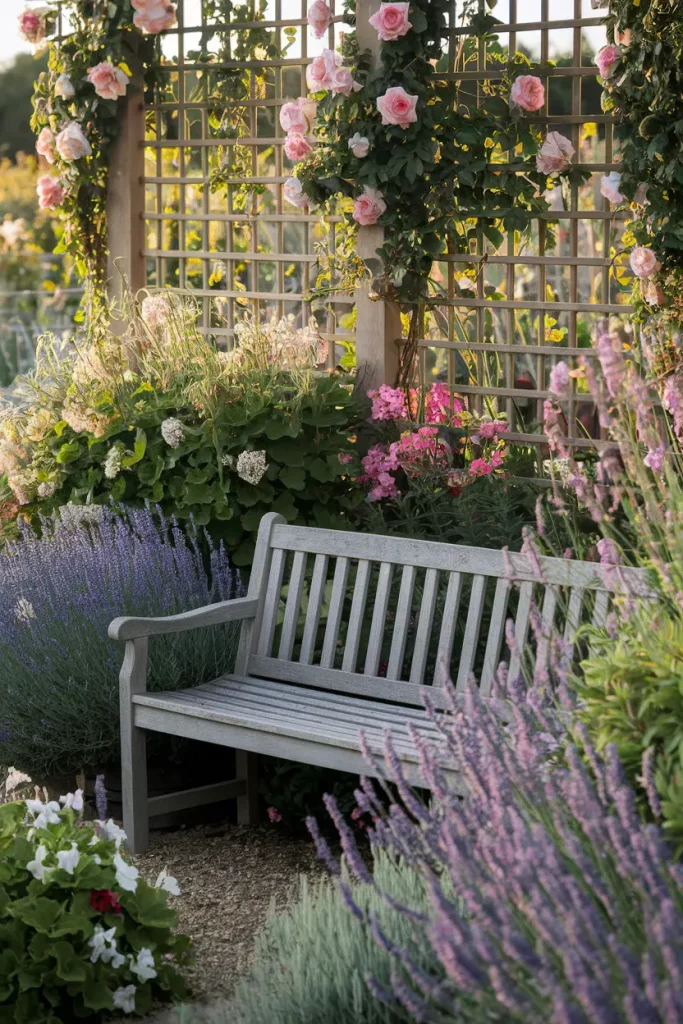
Creating intimate seating areas within small cottage gardens provides places to relax and enjoy your handiwork. I design these spaces to feel secluded and peaceful while remaining connected to the larger garden design through plant choices and material consistency.
Choose seating that complements cottage garden style while providing comfort for extended enjoyment. I prefer weathered wood benches, wrought iron chairs with soft cushions, or rustic stone seats that look natural in the garden setting. Avoid modern materials that clash with cottage aesthetics.
Surround seating areas with fragrant plants to enhance the sensory experience. I plant lavender, sweet peas, jasmine, and scented geraniums near benches and chairs where their fragrances can be appreciated up close. Evening-scented plants like four o’clocks and moonflowers create magical nighttime experiences.
Provide some shelter and privacy around seating areas without completely enclosing them. I use tall plants, trellises with climbing vines, or strategically placed shrubs to create partial screens that make seating areas feel intimate while maintaining views into other garden areas.
12. Butterfly and Pollinator Plants
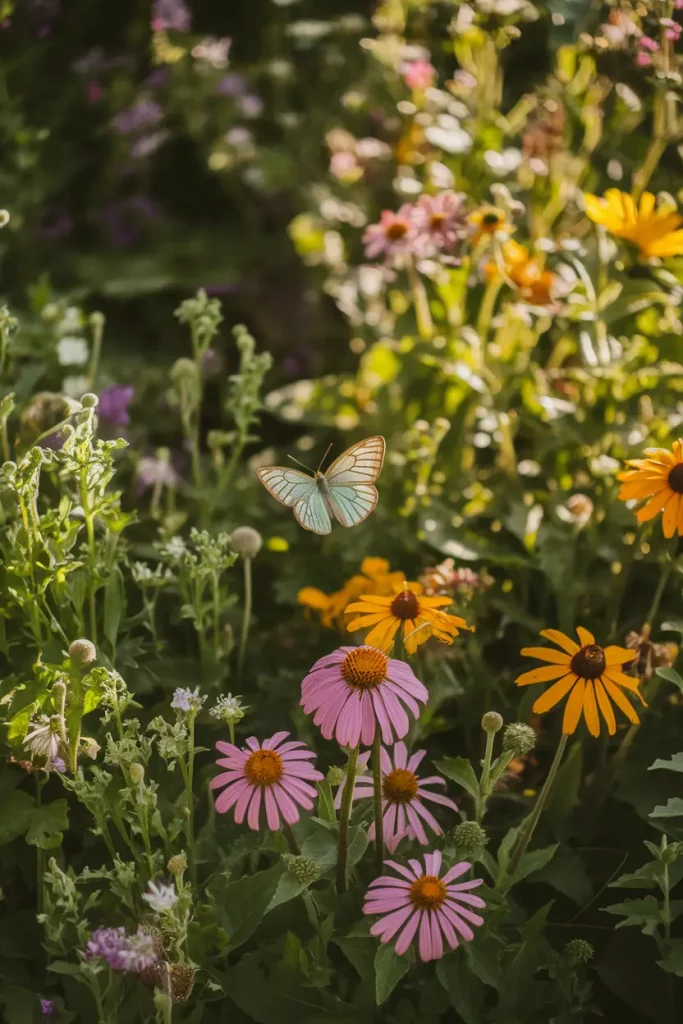
Attracting butterflies and beneficial insects creates living gardens full of movement and purpose. I select plants specifically for their appeal to pollinators, creating habitats that support local ecosystems while providing spectacular displays of natural beauty.
Choose native plants whenever possible, as they provide the best food sources and habitat for local butterfly and bee populations. I research which plants are indigenous to my area and incorporate them throughout the garden design. Native plants also tend to be more reliable and require less maintenance once established.
Provide host plants for butterfly larvae as well as nectar sources for adults. I grow parsley for swallowtail caterpillars, milkweed for monarchs, and violets for fritillary butterflies. This comprehensive approach supports complete butterfly life cycles rather than just adult feeding.
Create diverse bloom times to support pollinators throughout the growing season. I ensure something is blooming from early spring through late fall, providing consistent food sources when natural areas might be lacking. This includes early bulbs, summer perennials, and late-blooming asters and goldenrod.
13. Cottage Garden Tool Storage
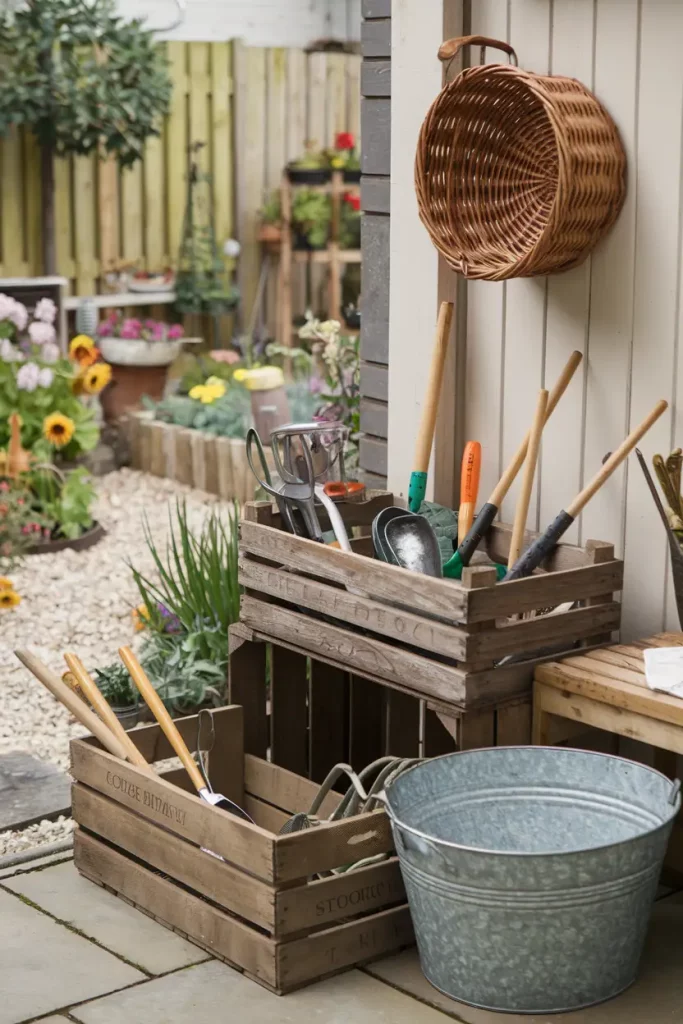
Functional storage solutions keep small cottage gardens organized while maintaining their charming aesthetic. I incorporate storage that doubles as decorative elements, choosing pieces that enhance rather than detract from the garden’s overall appearance.
Use vintage or vintage-style pieces for tool storage that fits cottage garden themes. I repurpose old wooden crates, galvanized buckets, and wicker baskets to hold hand tools, gloves, and supplies. These pieces age beautifully and become more attractive over time rather than looking worn out.
Position storage strategically throughout the garden to reduce carrying distances and encourage regular maintenance. I place tool storage near different work areas rather than centralizing everything in one location. This makes garden care more efficient and enjoyable.
Include covered storage for items that need protection from weather. I use a vintage-style potting bench with storage underneath, and weatherproof containers for fertilizers and pesticides. Proper storage extends tool life and keeps supplies readily available when needed.
14. Vertical Growing Solutions
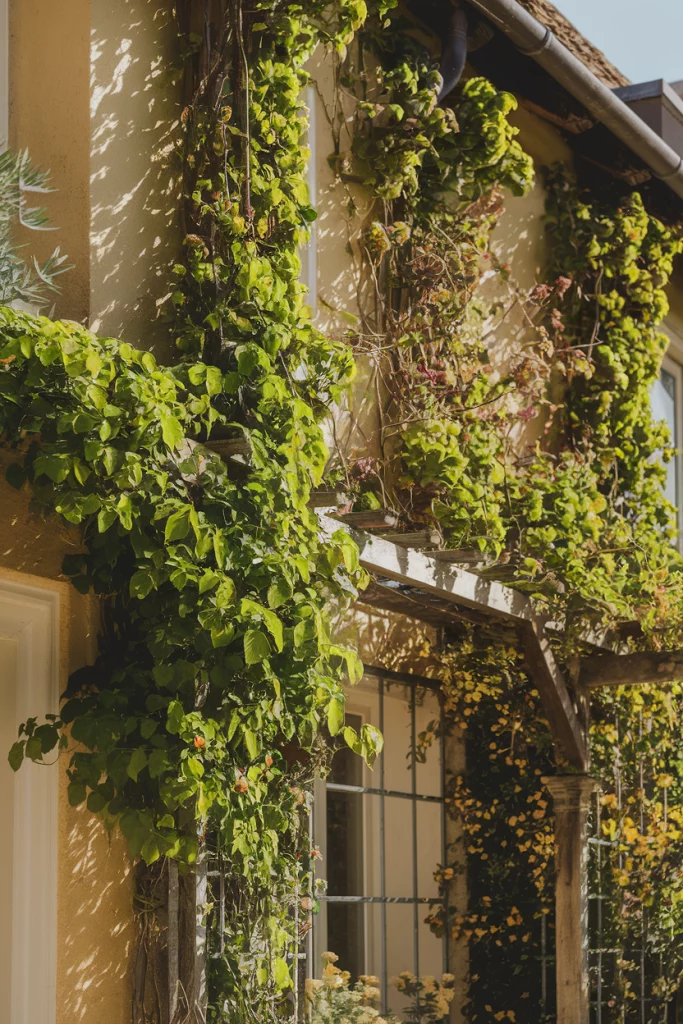
Maximizing vertical space allows small cottage gardens to support more plants while creating dramatic visual displays. I use various techniques to grow upward, from simple trellises to elaborate living walls that transform blank surfaces into productive garden space.
Install sturdy support structures before planting to avoid disturbing established plants later. I anchor trellises, arbors, and obelisks securely, ensuring they can support mature plant weight and wind loads. Proper installation prevents damage to both structures and plants.
Choose climbing plants suited to your specific growing conditions and support structures. I match vigorous growers like clematis and honeysuckle to strong supports, while using lighter vines like sweet peas on more delicate structures. Understanding plant habits prevents problems later.
Train climbing plants regularly during the growing season to maintain attractive coverage and prevent tangling. I tie new growth loosely to supports using soft materials, directing growth to fill gaps and create even coverage. Regular attention creates better displays with healthier plants.
15. Cottage Garden Lighting
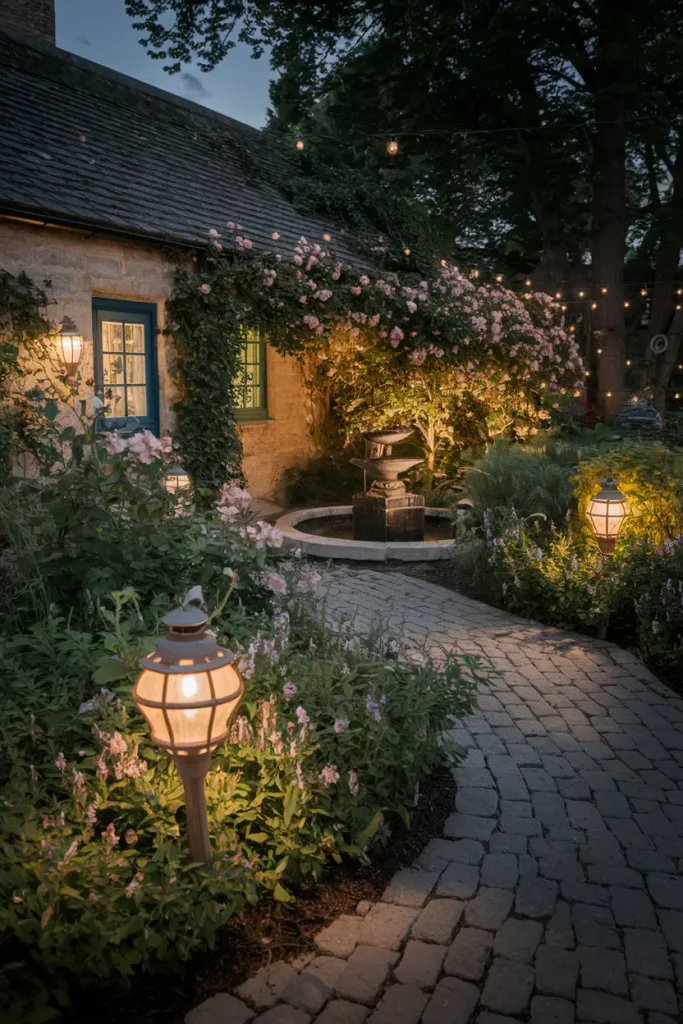
Thoughtful lighting extends garden enjoyment into evening hours while highlighting special features and providing safety along paths. I use various lighting techniques to create magical nighttime atmosphere without overwhelming the garden’s natural beauty.
Choose lighting fixtures that complement cottage garden style during daylight hours as well as after dark. I prefer weathered metal lanterns, ceramic path lights, and string lights with warm-toned bulbs that create inviting atmosphere without harsh glare or contemporary styling.
Highlight key garden features with subtle accent lighting rather than flooding the entire space with bright illumination. I use small spotlights to showcase specimen plants, water features, or architectural elements, creating focal points that draw attention and add drama.
Include functional lighting along paths and near seating areas for safety and usability. I install low-voltage path lights that provide adequate illumination without overpowering planted areas. Solar options work well in sunny locations and eliminate wiring concerns.
16. Cottage Garden Border Edging
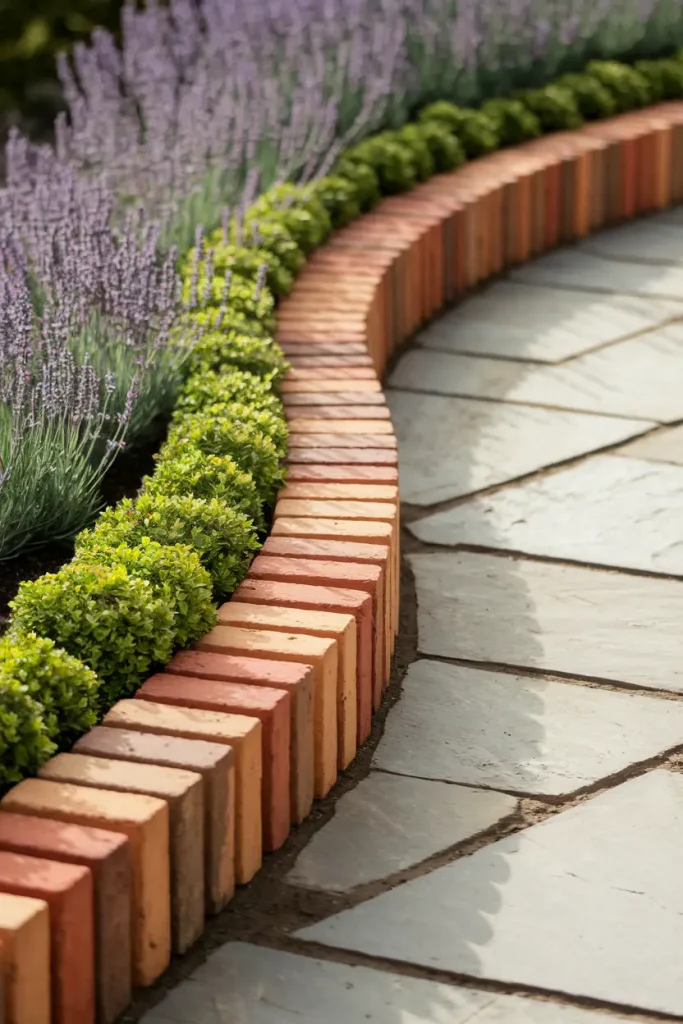
Defining garden borders with appropriate edging materials creates clean lines while maintaining cottage garden charm. I use natural materials that complement planted areas without creating harsh boundaries that feel too formal or structured for this relaxed garden style.
Traditional brick edging works beautifully in cottage gardens, especially when using reclaimed or weathered bricks that show age and character. I lay them in various patterns – soldier course for straight lines, basket weave for curved borders, or simply placed end-to-end for simple definition. The warm tones complement most flower colors.
Stone edging provides permanent, attractive borders that improve with age. I collect fieldstone, limestone, or local rock to create natural-looking edges that feel like they belong in the landscape. Irregular shapes and sizes create more interesting lines than perfectly uniform materials.
Living edges using low-growing plants offer the softest transition between lawn and garden beds. I plant compact varieties like boxwood, lavender, or catmint to create natural boundaries that blend seamlessly with other garden plants while still providing clear definition.
17. Compact Greenhouse Solutions
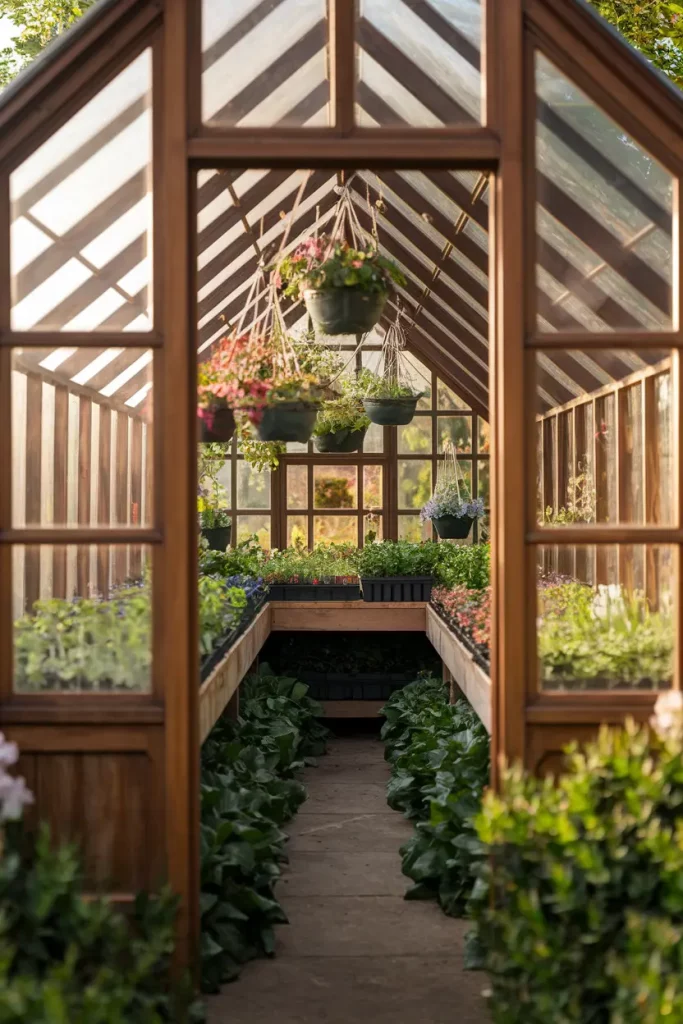
Small greenhouses extend growing seasons and protect tender plants in cottage gardens with limited space. I use mine for starting seeds, overwintering plants, and growing heat-loving crops that struggle in my climate’s short summers.
Choose greenhouse styles that complement your cottage garden aesthetic rather than stark modern designs. I prefer traditional Victorian-style structures with wooden frames and classic proportions, though well-designed lean-to models work beautifully against cottage walls or fences.
Position greenhouses carefully to maximize light while integrating them into the garden design. I placed mine where it receives morning sun but gets some afternoon shade during the hottest summer months. Good ventilation prevents overheating while maintaining the warm environment plants need.
Use greenhouse space efficiently with shelving, hanging baskets, and staged benches that accommodate plants of different heights. I grow trailing plants in hanging containers, place seed starting trays on tables, and use floor space for larger specimens that need room to spread.
18. Cottage Garden Compost Area
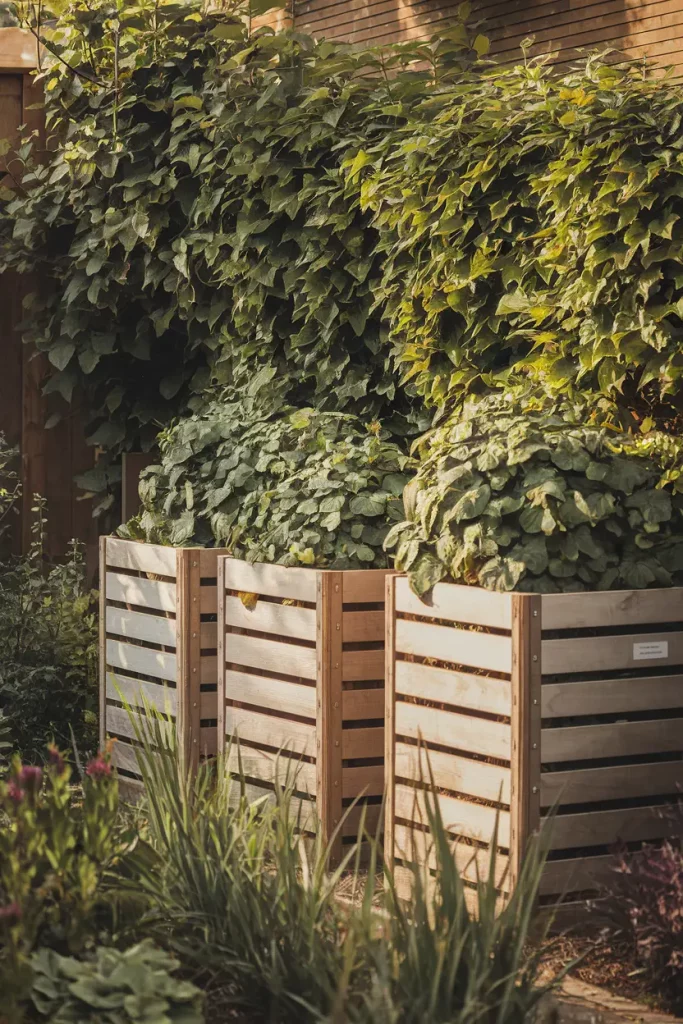
Composting transforms garden waste into valuable soil improvement while supporting sustainable gardening practices. I design my compost area to be functional yet attractive, treating it as an integral part of the garden rather than hiding it away.
Create compost systems that suit your space and aesthetic preferences. I use wooden bins constructed from cedar slats that age naturally and blend with other garden structures. Three-bin systems work well for continuous composting, while single bins or tumblers suit smaller spaces.
Position compost areas conveniently but discretely within the garden layout. I place mine near the vegetable garden for easy access but screen it partially with tall plants or decorative fencing. Good drainage and air circulation are essential for proper decomposition.
Include attractive plantings around compost areas to integrate them into the garden design. I grow vigorous perennials like comfrey, Jerusalem artichoke, or tall grasses that benefit from the rich soil near compost bins while providing visual screening.
19. Seasonal Container Displays
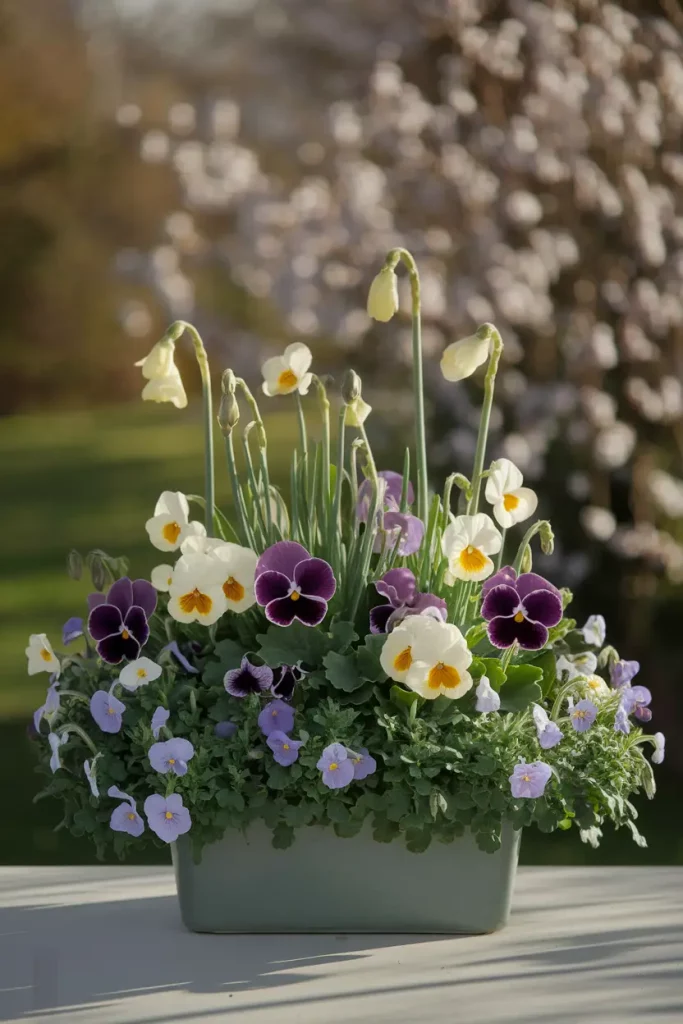
Rotating container plantings throughout the seasons keeps cottage gardens interesting while allowing experimentation with different plant combinations. I plan seasonal displays that complement permanent plantings while adding flexibility to the garden design.
Spring containers focus on early color and fresh growth after winter dormancy. I plant cool-season flowers like pansies, primrose, and sweet peas combined with early bulbs and emerging perennials. These combinations provide hope and energy after months of winter quiet.
Summer displays emphasize abundant blooms and lush foliage that can handle heat and drought. I combine heat-tolerant annuals like petunias, marigolds, and zinnias with herbs and vegetables that thrive in warm conditions. Regular watering and feeding keep these displays looking fresh.
Fall containers celebrate the season’s rich colors and textures while extending garden interest into cooler months. I use ornamental kale, chrysanthemums, asters, and ornamental grasses combined with small pumpkins or gourds for festive autumn appeal.
See also: 33 Cozy Black Boho Bedroom Ideas You’ll Love
20. Cottage Garden Rain Collection
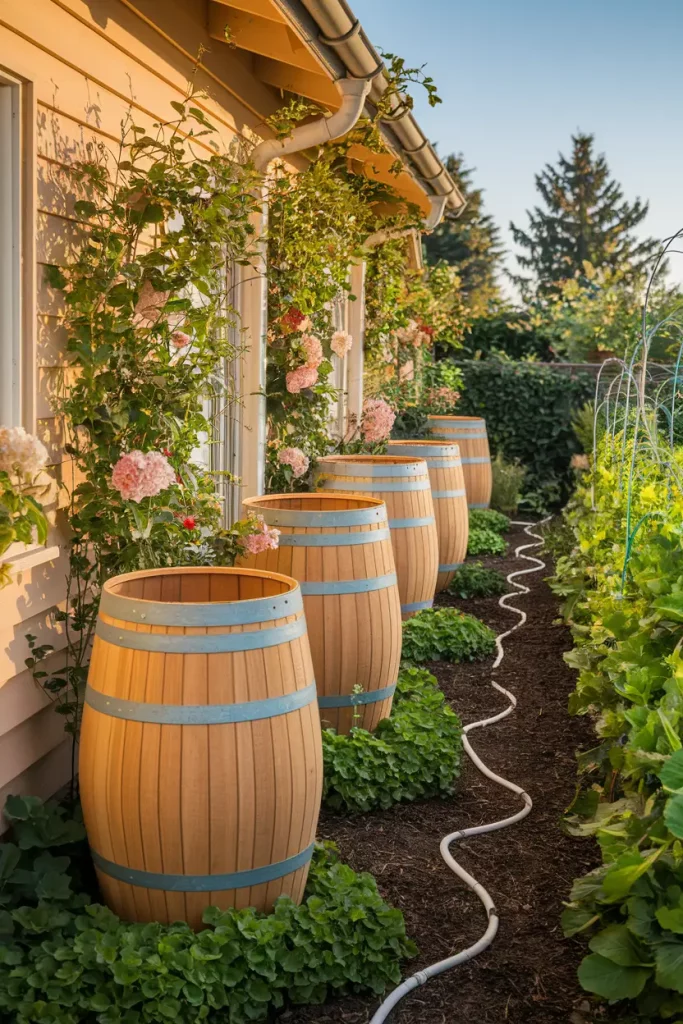
Collecting rainwater provides sustainable irrigation while adding functional beauty to cottage gardens. I incorporate rain collection systems that serve practical needs while enhancing the garden’s overall design and ecological sustainability.
Install rain barrels or cisterns that complement cottage garden aesthetics rather than looking purely utilitarian. I prefer wooden barrels or decorative ceramic vessels that look intentional and attractive rather than industrial. Painting or staining can customize containers to match garden color schemes.
Position collection systems strategically to maximize water capture while maintaining garden flow and accessibility. I place barrels near downspouts but screen them partially with plantings or decorative elements. Easy access for watering cans and hoses is essential for practical use.
Use collected rainwater efficiently through drip irrigation or soaker hoses that deliver water directly to plant roots. I connect simple distribution systems to rain barrels, reducing waste while providing consistent moisture to plants that need regular watering.
21. Fragrant Plant Gardens
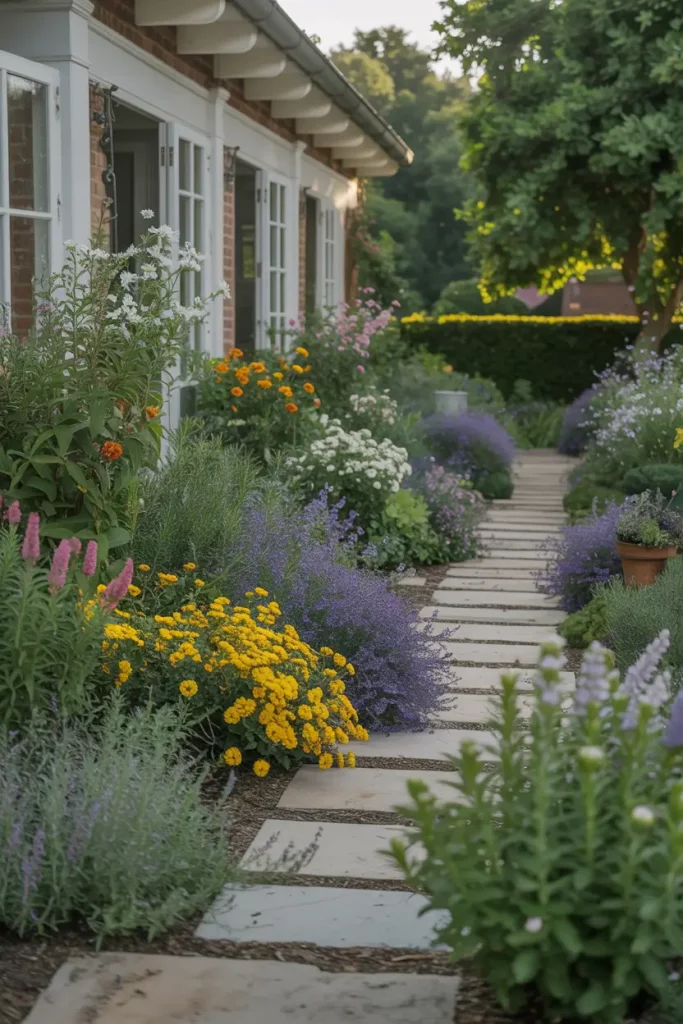
Incorporating fragrant plants throughout cottage gardens creates multi-sensory experiences that engage visitors on deeper levels. I select plants for their scents as carefully as their visual appeal, creating aromatic landscapes that smell as wonderful as they look.
Position fragrant plants strategically where their scents can be appreciated most effectively. I place them near seating areas, along pathways, and beneath windows where breezes will carry fragrances. Evening-scented plants go near outdoor dining areas or bedroom windows.
Choose fragrances that complement rather than compete with each other. I group plants with similar scent families together – spicy herbs in one area, sweet flowers in another, citrus scents near outdoor cooking spaces. This creates distinct aromatic zones within the garden.
Include plants that release fragrance at different times and through different triggers. I grow flowers that smell strongest in evening hours, herbs that release scent when brushed against, and plants whose fragrances intensify after rain showers.
22. Wildlife Habitat Features
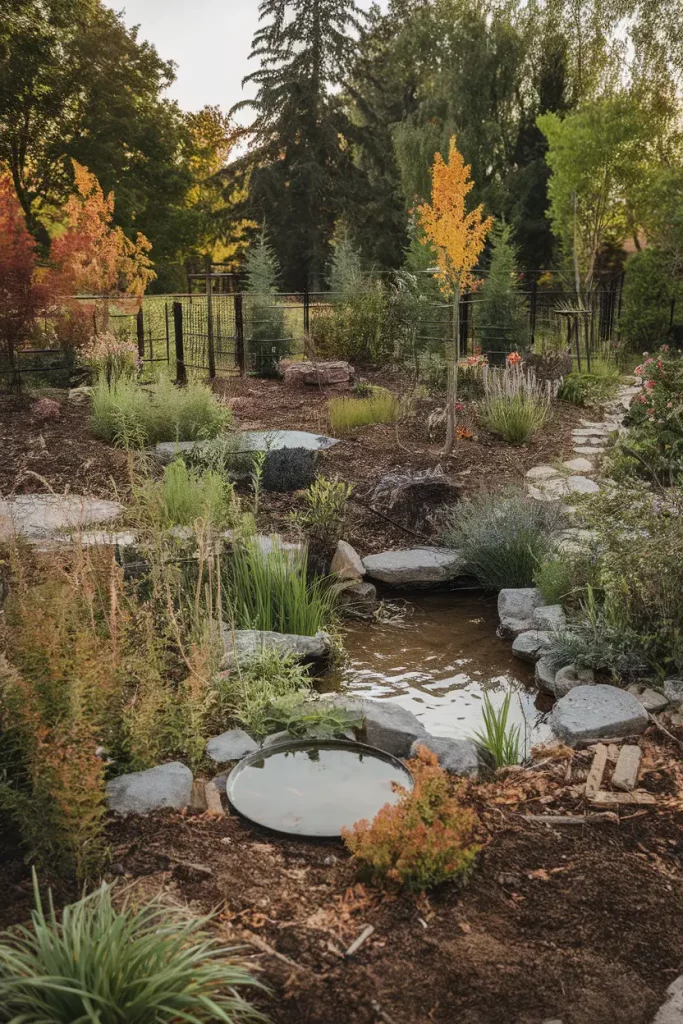
Creating habitat for beneficial wildlife transforms cottage gardens into living ecosystems that support local fauna while providing natural pest control and pollination services. I incorporate features that attract birds, beneficial insects, and small mammals.
Provide diverse plant layers that offer food and shelter for different wildlife species. I include tall trees for nesting birds, shrubs for cover and berries, and ground-level plants for insects and small creatures. This vertical diversity supports more wildlife than single-layer plantings.
Install features that provide water access for wildlife throughout the year. I maintain shallow dishes for drinking, small pools for bathing, and dripping water sources that attract birds through sound. Fresh water availability dramatically increases wildlife garden visits.
Leave some wild areas unmaintained to provide natural habitat and overwintering sites. I allow fallen leaves to remain in corner areas, leave flower stalks standing through winter, and maintain brush piles where beneficial insects can shelter during cold months.
23. Cottage Garden Focal Points
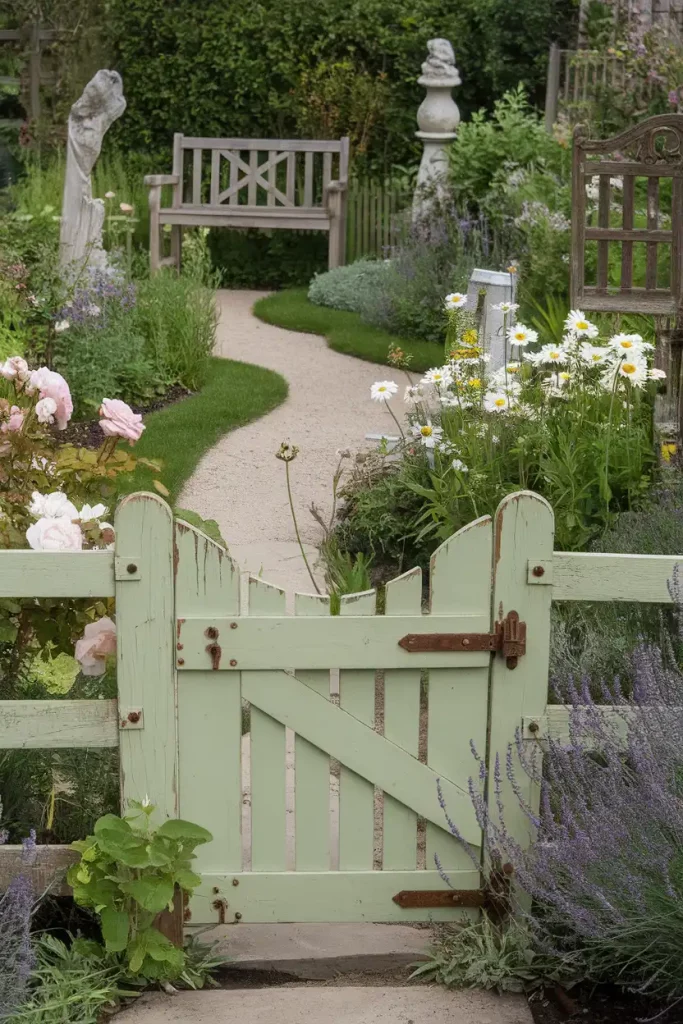
Strong focal points anchor cottage garden designs while providing visual destinations that draw visitors through the space. I create focal points using plants, structures, or decorative elements that command attention without overwhelming the garden’s relaxed character.
Choose focal points that reflect cottage garden style and personal interests. I use elements like vintage garden gates, weathered statuary, distinctive plant specimens, or handcrafted bird houses that add personality while maintaining authentic cottage appeal.
Position focal points strategically to create visual flow and encourage exploration. I place them at path intersections, garden entrances, or destinations like seating areas where they provide natural stopping points and conversation starters for garden visitors.
Scale focal points appropriately for garden size and surrounding plantings. I ensure featured elements are large enough to command attention but not so overwhelming that they dominate the space or compete with planted areas for visual prominence.
24. Cottage Garden Mulching
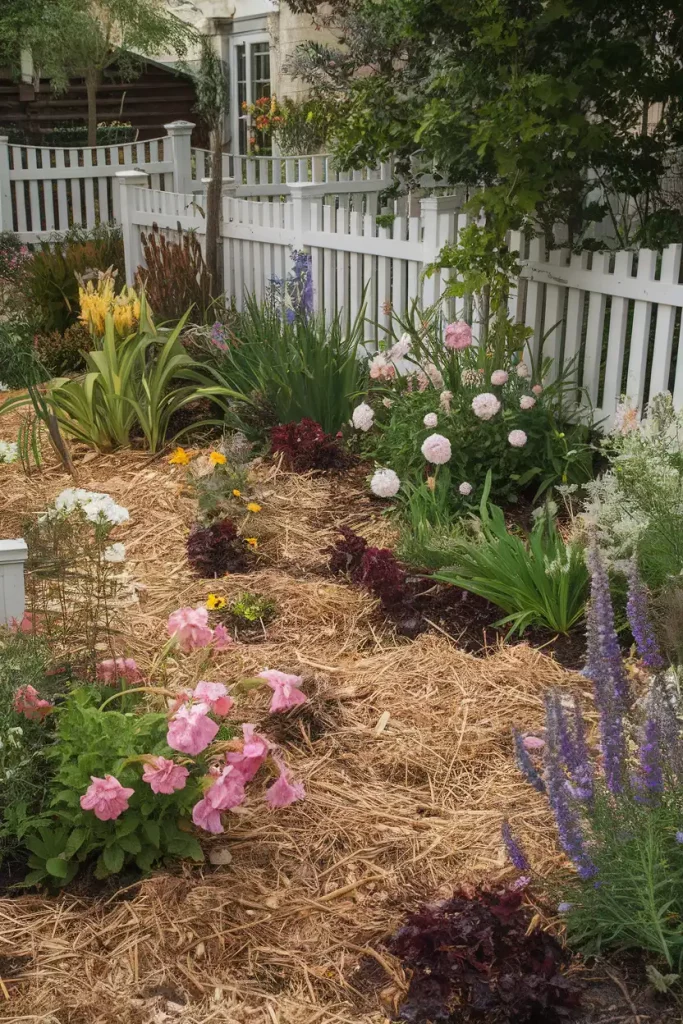
Strategic mulching conserves moisture, suppresses weeds, and improves soil while maintaining cottage garden aesthetics. I choose mulch materials that enhance rather than detract from planted areas, using organic options that break down and enrich soil over time.
Select mulch materials that complement cottage garden style and plant needs. I prefer natural options like shredded leaves, grass clippings, straw, or aged wood chips that look organic and weather naturally. Avoid synthetic mulches that appear artificial or overly uniform.
Apply mulch properly to maximize benefits while preventing plant problems. I maintain two to three-inch depths around plants, keeping mulch away from plant stems to prevent moisture-related diseases. Proper application technique ensures effectiveness without creating issues.
Refresh mulch regularly to maintain appearance and effectiveness throughout the growing season. I add new material as needed, incorporating decomposed mulch into soil where it improves structure and fertility. This ongoing process builds soil health over time.
25. Small Space Orchard
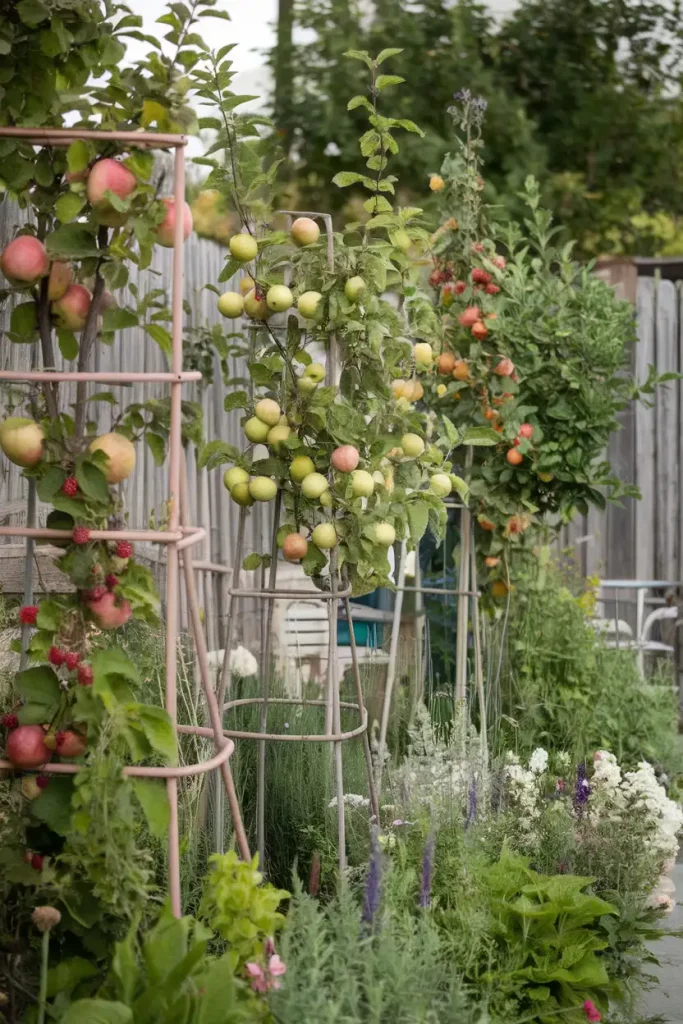
Incorporating fruit trees and berry bushes into cottage gardens provides food while adding structure and seasonal interest. I choose compact varieties and use training techniques that maximize production within limited space while maintaining garden aesthetics.
Select fruit varieties suited to small spaces and cottage garden style. I prefer dwarf or semi-dwarf trees that won’t overwhelm other plantings, and varieties with attractive flowers, foliage, or growth habits that contribute to garden beauty beyond fruit production.
Use espalier and other training techniques to maximize fruit production in minimal space. I train apple and pear trees against walls or fences, creating living artwork that produces food while serving as attractive garden features. These techniques require patience but provide excellent results.
Integrate fruit plants throughout the garden rather than segregating them in separate orchard areas. I scatter berry bushes among ornamental plantings and use fruit trees as specimen plants in mixed borders. This approach maximizes space while creating diverse, productive landscapes.
26. Cottage Garden Pathways
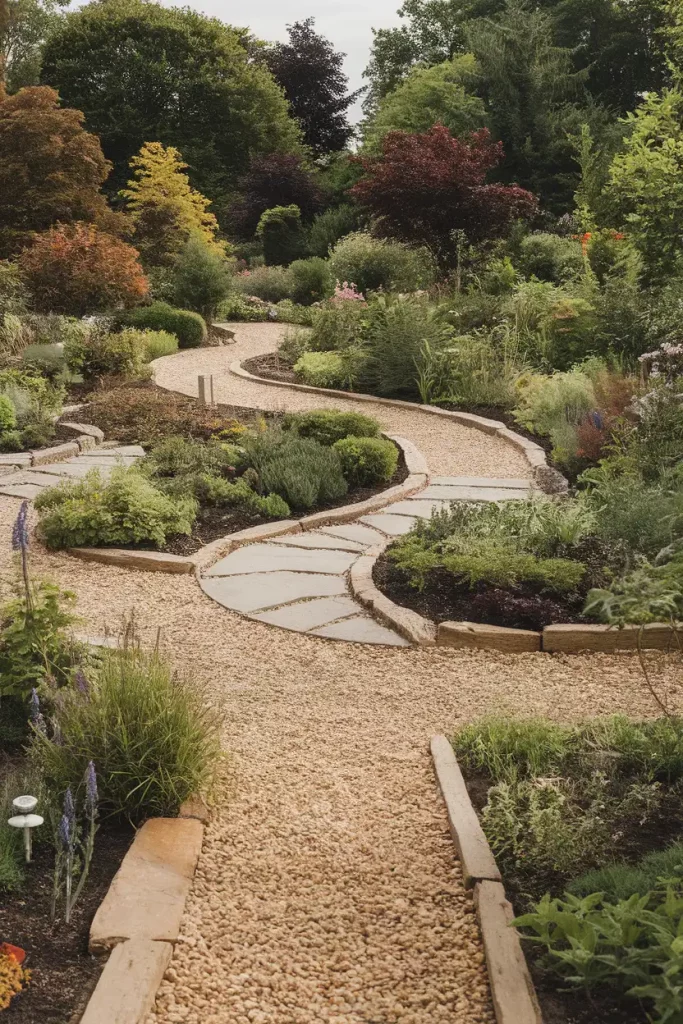
Well-designed pathways guide visitors through cottage gardens while providing practical access for maintenance and enjoyment. I create paths that enhance the garden experience while serving functional needs for walking, working, and moving equipment.
Design pathways that complement cottage garden’s informal character while providing adequate functionality. I prefer curved routes that reveal garden areas gradually rather than straight lines that expose everything at once. Mystery and discovery make gardens more engaging.
Choose pathway materials that age gracefully and complement planted areas. I use combinations of natural stone, brick, gravel, and planted stepping stones that develop character over time. Mixed materials create more interesting surfaces than single uniform options.
Vary pathway widths to create hierarchy and visual interest throughout the garden. I make primary routes wide enough for comfortable walking and wheelbarrow access, while creating narrower secondary paths for intimate garden exploration and maintenance access.
27. Cottage Garden Plant Supports
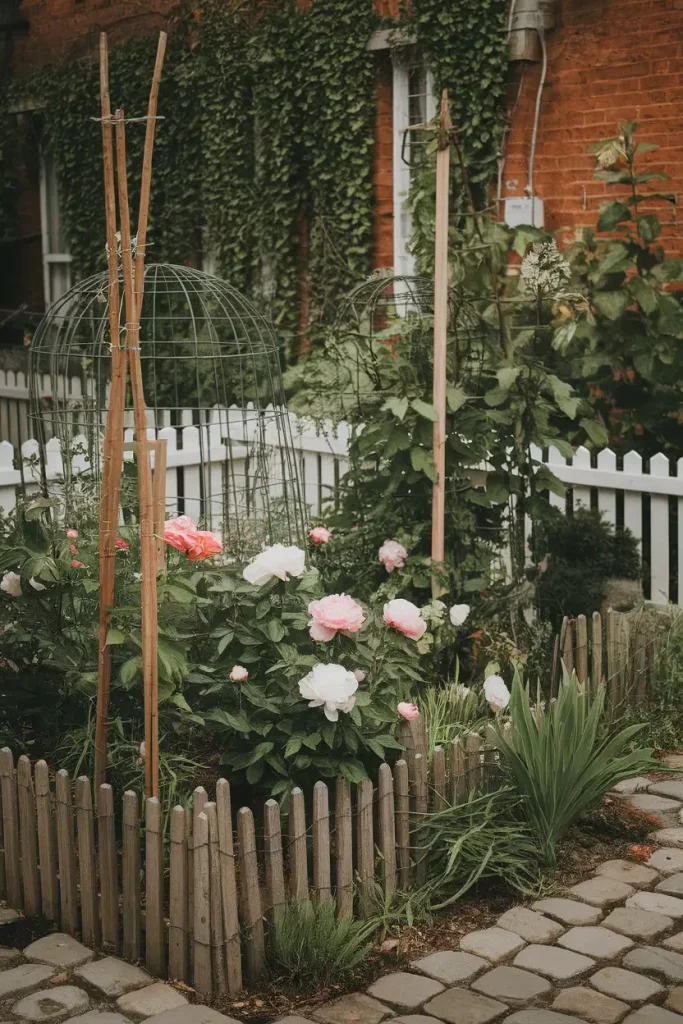
Providing attractive plant supports keeps cottage gardens looking tidy while allowing plants to grow naturally. I use supports that enhance garden aesthetics while serving practical functions, choosing materials and designs that complement rather than dominate planted areas.
Install plant supports early in the growing season before plants need them rather than waiting until problems develop. I place stakes, cages, and trellises when plants are small, allowing them to grow into and around supports naturally for more attractive results.
Choose support materials that match cottage garden style and weather gracefully over time. I prefer natural materials like bamboo, wood, and wrought iron that develop patina and character rather than plastic or synthetic options that always look artificial.
Design support systems that accommodate plant growth habits and mature sizes. I research how plants grow and what support they need, providing appropriate structures that prevent damage while allowing natural movement and development.
28. Cottage Garden Seed Starting
Starting plants from seed provides access to unusual varieties while reducing gardening costs and increasing personal satisfaction. I dedicate space and time to seed starting, treating it as an enjoyable part of the gardening process rather than just a means to an end.
Create dedicated spaces for seed starting that provide proper conditions for germination and early growth. I use combinations of indoor growing areas with supplemental lighting and protected outdoor spaces like cold frames or small greenhouses.
Choose seeds that offer advantages over purchased plants, focusing on varieties that are difficult to find, expensive to buy, or particularly well-suited to cottage garden style. I grow heirloom varieties and unusual cultivars that add unique character to garden displays.
Time seed starting appropriately for your climate and growing season to ensure plants are ready when outdoor conditions become suitable. I keep detailed records of sowing dates and results, improving timing and success rates through experience and observation.
29. Cottage Garden Maintenance
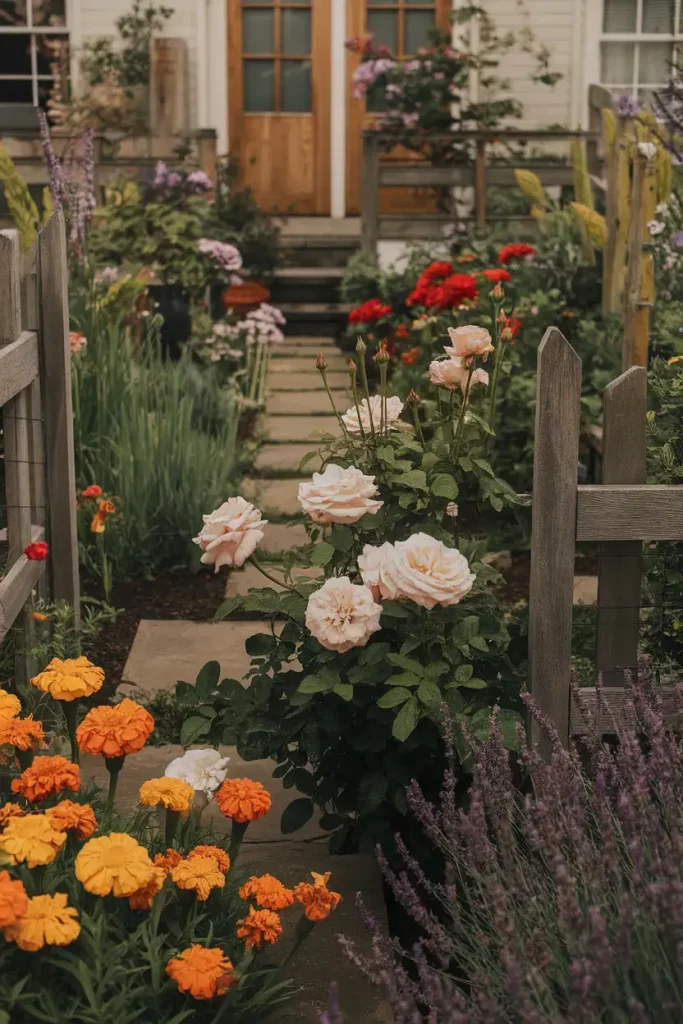
Regular maintenance keeps cottage gardens healthy and attractive while preserving their characteristically relaxed appearance. I develop maintenance routines that support plant health and garden beauty without making spaces look overly manicured or formal.
Establish maintenance schedules that address seasonal needs while fitting into available time and energy. I focus on essential tasks like watering, deadheading, and basic weeding while allowing some natural aging and self-seeding that adds to cottage garden charm.
Use maintenance activities as opportunities to observe and interact with garden plants and wildlife. I treat weeding, pruning, and harvesting as meditative activities that provide stress relief while keeping gardens healthy and productive.
Balance tidiness with natural cottage garden character by maintaining plants without eliminating their informal appearance. I remove spent flowers and damaged foliage while allowing some self-seeding and natural plant interactions that create authentic cottage appeal.
30. Cottage Garden Seasonal Preparation
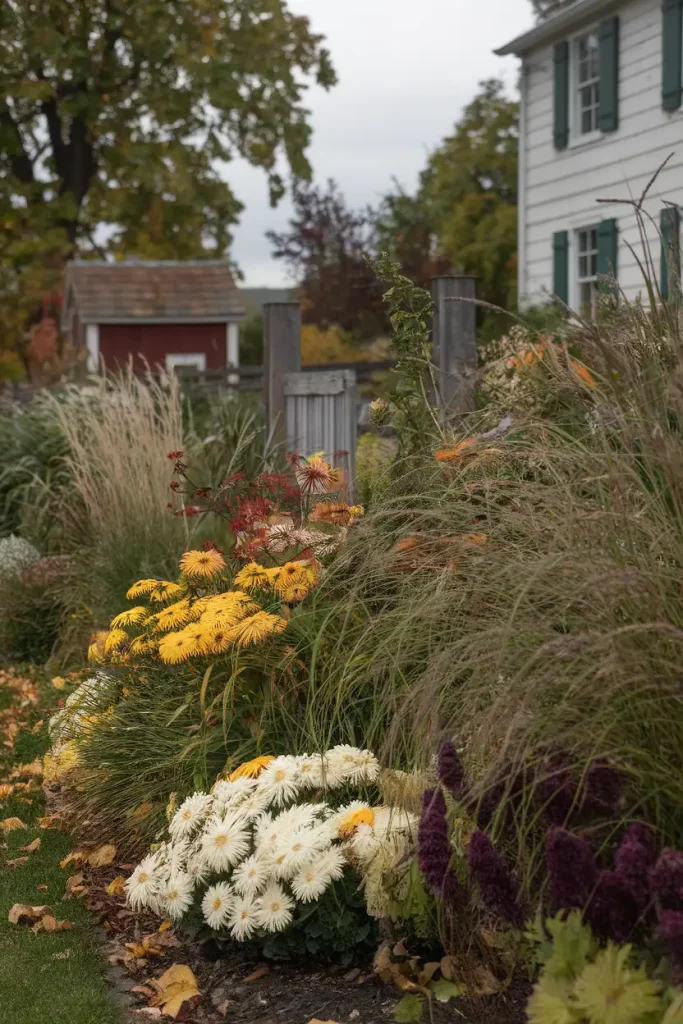
Preparing cottage gardens for seasonal transitions ensures plant survival and continued beauty throughout the year. I develop routines that protect plants while maintaining garden structure and interest during dormant periods.
Prepare gardens for winter by protecting tender plants while leaving structural elements for cold-season interest. I cut back some perennials while leaving others standing for wildlife habitat and visual appeal. Seed heads and dried foliage provide winter beauty.
Plan spring preparation activities that support vigorous growth and abundant flowering in the coming season. I divide overcrowded perennials, add compost to beds, and prepare planting areas for new additions while cleaning up winter damage.
Use seasonal transitions as opportunities to evaluate garden performance and plan improvements. I assess which plants thrived, which struggled, and what changes might improve results. This ongoing evaluation leads to better gardens over time.
31. Cottage Garden Color Schemes
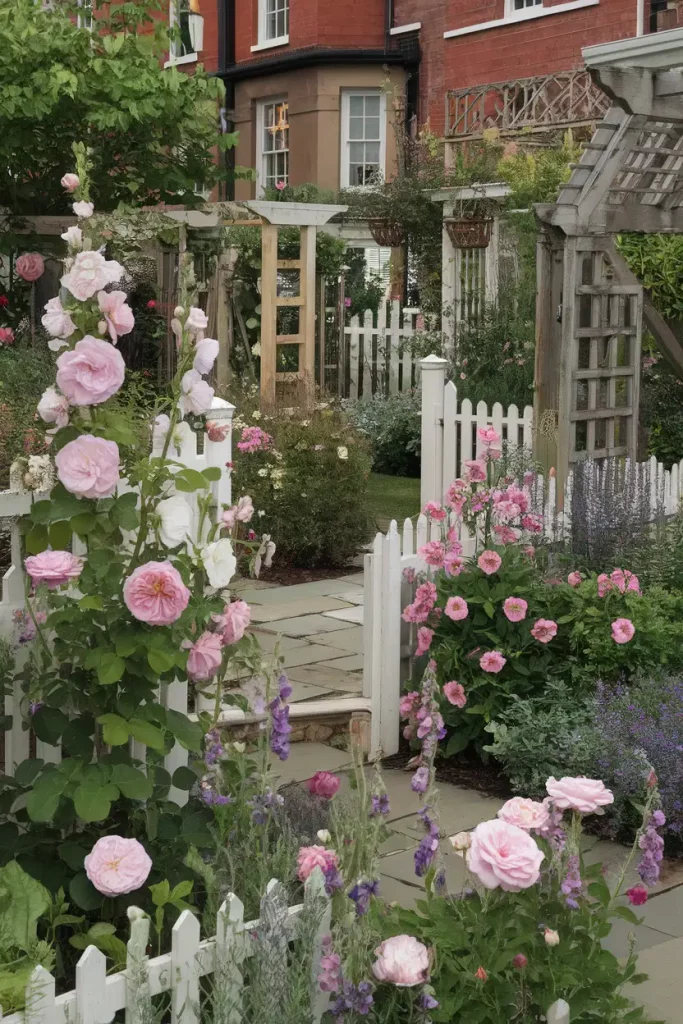
Developing cohesive color schemes creates visual harmony in cottage gardens while maintaining their characteristic abundance and variety. I plan color combinations that feel intentional yet relaxed, avoiding rigid formality while ensuring pleasing visual relationships throughout the space.
Traditional cottage gardens favor soft, romantic colors that blend harmoniously rather than creating stark contrasts. I use plenty of whites, creams, soft pinks, lavenders, and pale yellows as foundation colors, adding deeper purples, roses, and blues for richness and depth.
Create color echoes throughout the garden by repeating key hues in different areas and plant types. I might use pink in roses, hollyhocks, and sweet peas, tying different garden sections together through consistent color themes while maintaining plant diversity.
Consider foliage colors as important as flower colors when planning garden schemes. I incorporate plants with silver, gray, purple, or variegated leaves that provide color interest between blooming periods while creating sophisticated backdrops for flower displays.
32. Cottage Garden Ground Covers
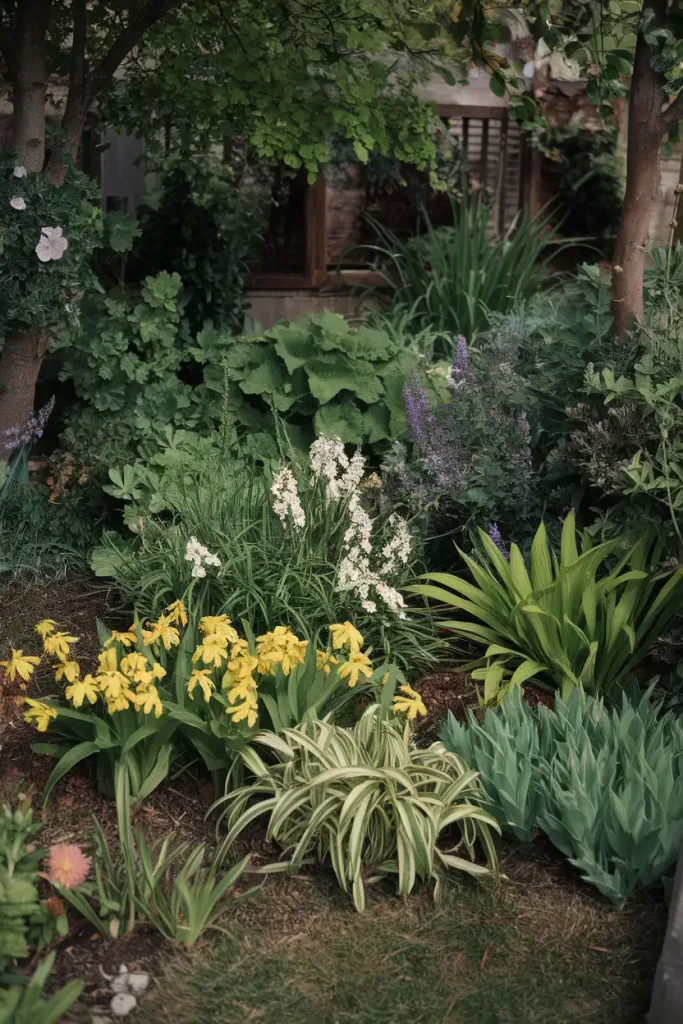
Strategic ground cover plantings suppress weeds, conserve moisture, and create unified looks in cottage gardens while reducing maintenance needs. I choose spreading plants that complement rather than compete with featured specimens, filling gaps naturally.
Select ground covers that suit specific growing conditions while maintaining cottage garden character. I use different plants for sunny and shady areas, dry and moist locations, ensuring each ground cover thrives in its designated space while providing effective coverage.
Plant ground covers that offer seasonal interest beyond basic weed suppression. I choose varieties with attractive flowers, colorful foliage, or interesting textures that contribute to garden beauty while serving practical functions. Multi-purpose plants maximize small space value.
Allow ground covers to naturalize and spread gradually rather than trying to achieve instant coverage. I plant smaller quantities and let them establish naturally, creating more authentic-looking results than formal mass plantings while reducing initial costs.
33. Cottage Garden Succession Planting
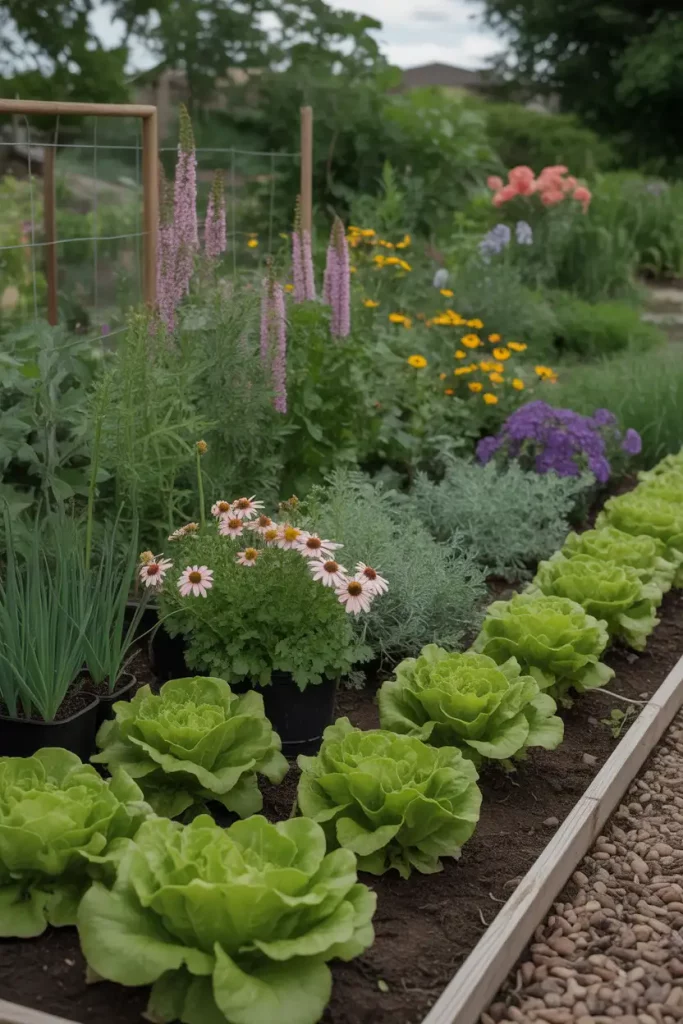
Planning plant succession ensures continuous garden interest and productivity throughout the growing season. I stagger plantings and choose varieties with different maturity dates, maintaining consistent beauty and harvest while maximizing space efficiency.
Practice succession planting with both ornamental and edible crops to maintain garden abundance. I plant new rows of lettuce and flowers every few weeks, ensuring fresh supplies and continuous color rather than brief peaks followed by empty spaces.
Choose plants with naturally staggered bloom times to create seamless seasonal transitions without replanting. I combine early, mid, and late-season varieties of the same plant types, extending flowering periods while reducing maintenance requirements.
Plan ahead for succession by preparing planting areas and purchasing seeds or plants in advance. I keep detailed planting schedules and prepare backup plants to fill gaps quickly when needed, maintaining garden continuity through careful planning.
34. Cottage Garden Indoor-Outdoor Connections
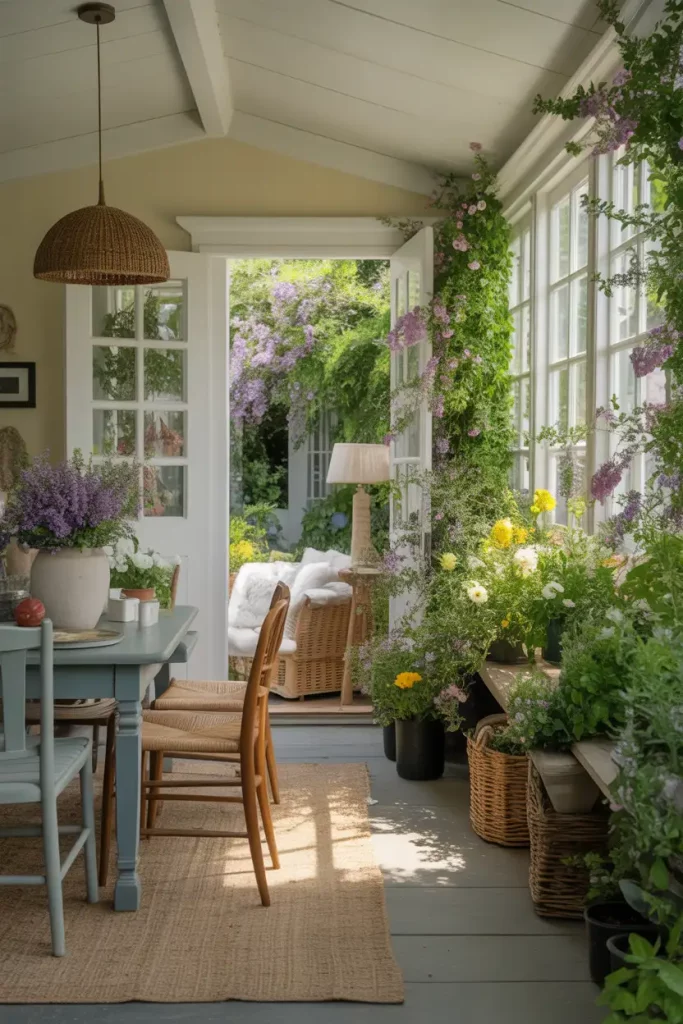
Creating strong connections between indoor and outdoor spaces extends cottage garden charm throughout the home while making both areas feel larger and more integrated. I design gardens that complement home interiors while bringing natural beauty closer to daily life.
Plant fragrant flowers and herbs near windows and doors where their scents can drift indoors naturally. I position jasmine, honeysuckle, and aromatic herbs strategically to perfume indoor spaces while creating seamless sensory transitions between inside and outside.
Use similar color schemes and plant materials in indoor and outdoor spaces to create visual continuity. I bring garden flowers indoors for arrangements while choosing houseplants that complement outdoor garden colors and textures.
Design outdoor seating and dining areas that function as extensions of interior rooms, creating comfortable transitions between indoor and outdoor living. I treat porches, patios, and garden seating as outdoor rooms with similar comfort and functionality as indoor spaces.
35. Cottage Garden Problem Solving
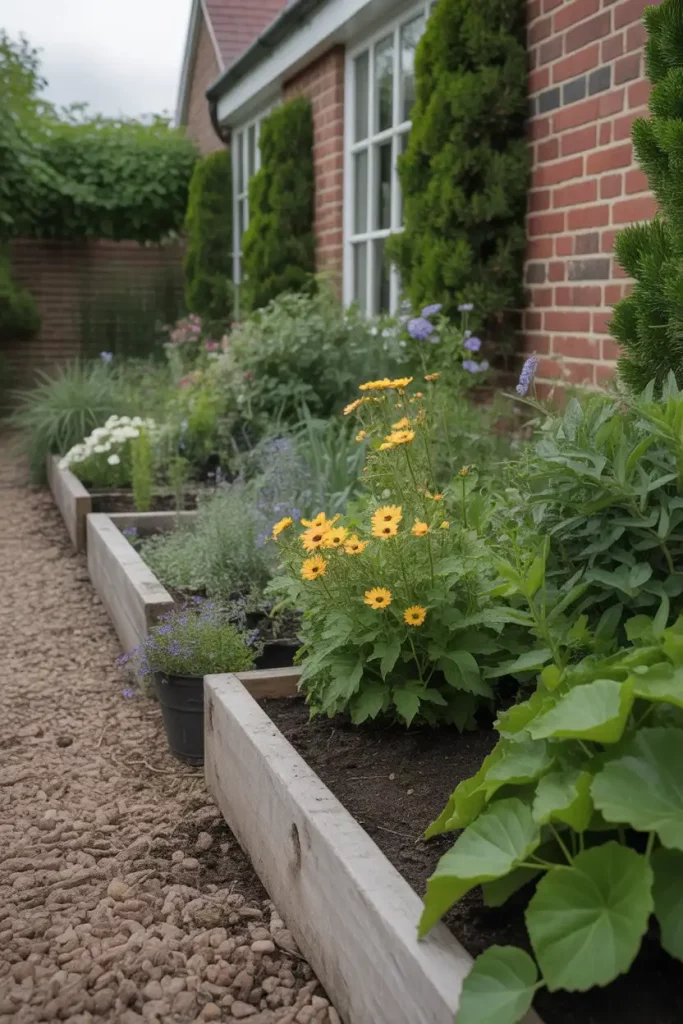
Addressing common cottage garden challenges requires creative solutions that maintain garden beauty while solving practical problems. I approach difficulties as opportunities for innovation rather than obstacles to success.
Deal with poor soil conditions through gradual improvement rather than complete replacement. I add organic matter regularly, use appropriate plants for existing conditions, and improve soil incrementally over several seasons while maintaining attractive gardens throughout the process.
Manage challenging microclimates by choosing appropriate plants and creating favorable conditions through garden design. I use walls, fences, and other plants to create shelter, improve drainage in wet areas, and provide shade where needed.
Address pest and disease problems through integrated management that emphasizes prevention and natural solutions. I encourage beneficial insects, choose resistant plant varieties, and maintain garden hygiene while avoiding harsh chemical treatments that disrupt garden ecosystems.
36. Cottage Garden Budget Strategies
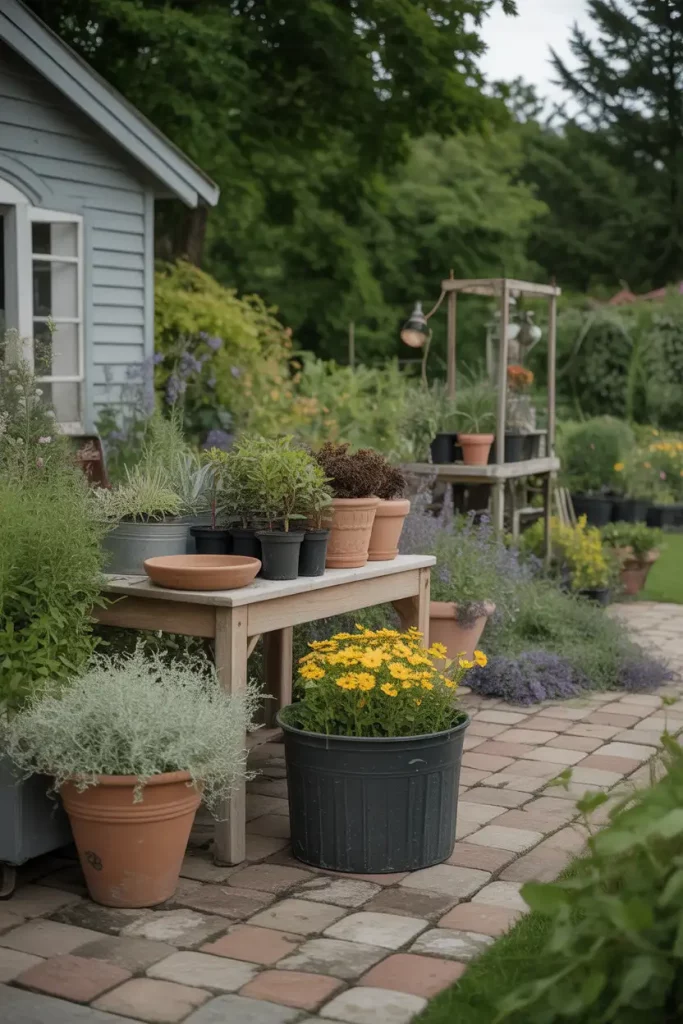
Creating beautiful cottage gardens within limited budgets requires strategic planning and creative resource use. I prioritize spending on long-term investments while finding economical sources for plants, materials, and garden improvements.
Start plants from seeds and cuttings rather than purchasing mature specimens for every garden need. I maintain seed-starting equipment and propagation areas that provide plants at fraction of retail costs while offering access to unusual varieties.
Source materials creatively through salvage yards, estate sales, and community exchanges. I find attractive containers, garden structures, and decorative elements at bargain prices while adding character that new items cannot provide.
Focus spending on permanent improvements like soil amendments, quality tools, and structural elements that provide long-term value. I invest in items that will serve the garden for many years while economizing on seasonal plants and temporary decorations.
37. Cottage Garden Plant Combinations
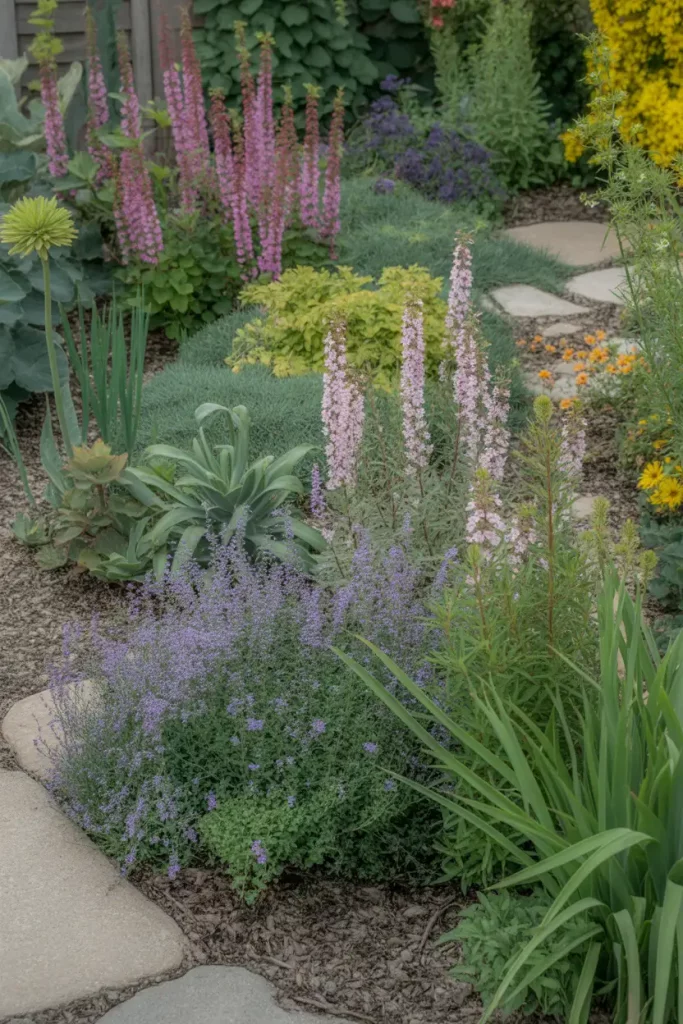
Successful plant combinations create visual harmony while supporting each other’s growth and health. I choose plants that complement each other in color, texture, form, and growing requirements, creating partnerships that enhance both individual and collective beauty.
Combine plants with different bloom times to extend seasonal interest in each garden area. I pair early spring bulbs with later-emerging perennials, ensuring continuous color while maximizing space efficiency through temporal layering.
Mix plant forms and textures to create visual interest and natural-looking combinations. I combine upright plants with mounding forms, fine textures with bold foliage, and different growth habits to create dynamic, engaging plant partnerships.
Choose companion plants that provide mutual benefits through pest control, soil improvement, or microclimate modification. I pair plants that naturally support each other’s health and vigor while creating more resilient, sustainable garden ecosystems.
38. Cottage Garden Heritage Varieties
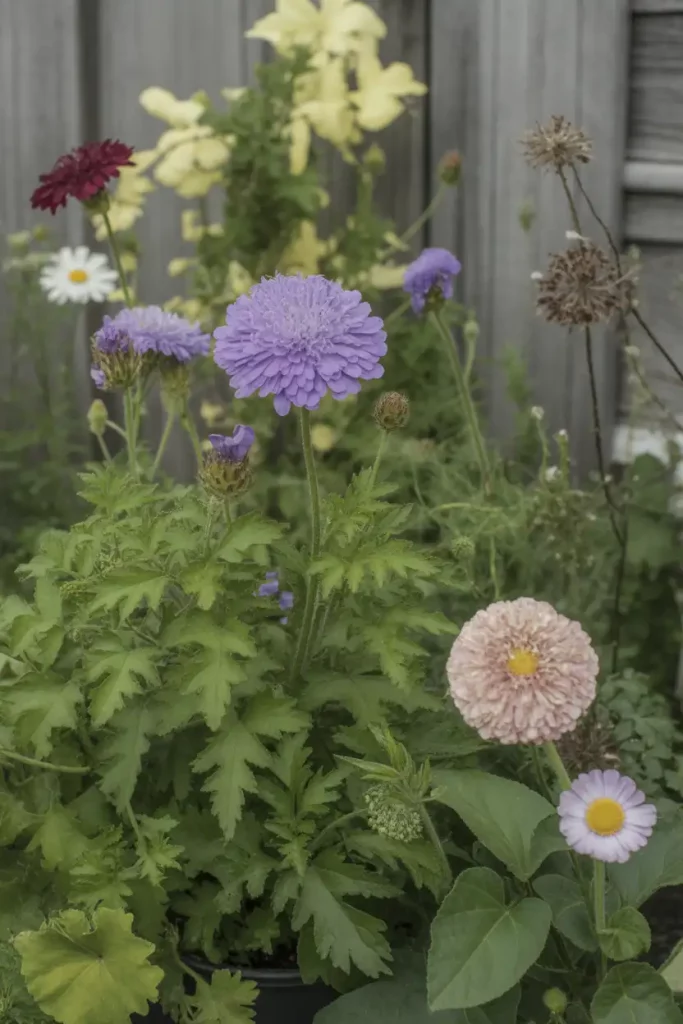
Growing heritage and heirloom plant varieties connects cottage gardens to their historical roots while preserving genetic diversity and cultural traditions. I seek out old varieties that offer unique characteristics and authentic cottage garden appeal.
Research the history and characteristics of heritage varieties to understand their cultural significance and growing requirements. I learn about plant origins, traditional uses, and historical importance while ensuring I can provide appropriate growing conditions.
Source heritage plants through specialty nurseries, seed exchanges, and gardening organizations dedicated to preserving old varieties. I participate in seed swaps and heritage plant societies that provide access to rare varieties while supporting conservation efforts.
Share heritage varieties with other gardeners through seed saving and plant exchanges, continuing traditions of community sharing that characterize cottage gardening culture. I maintain seed stocks and propagate plants for sharing with fellow gardeners.
39. Cottage Garden Seasonal Containers
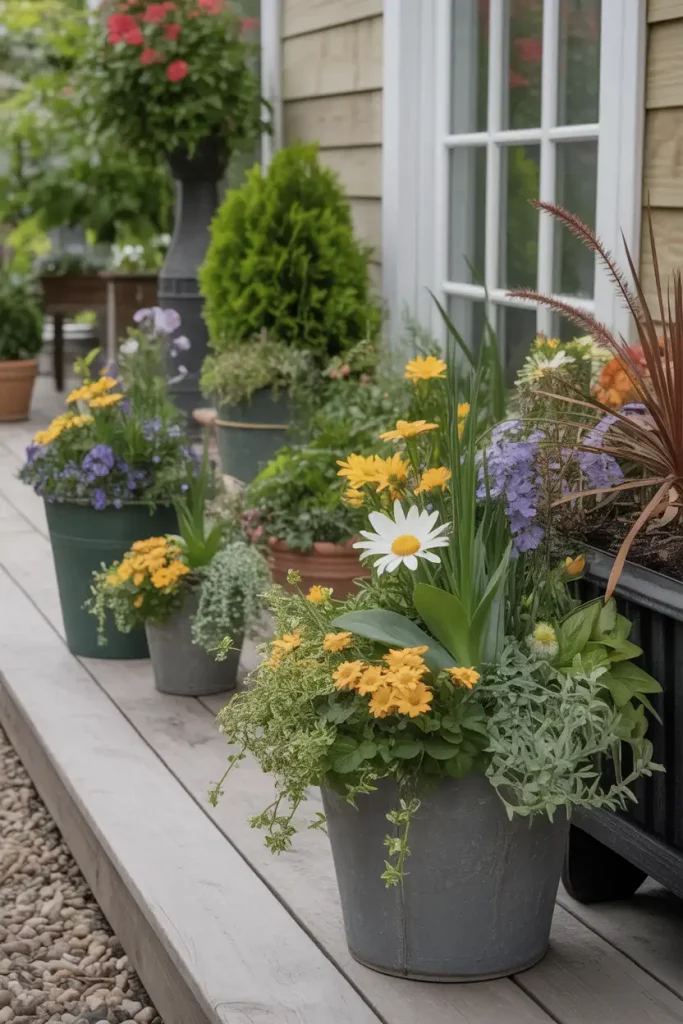
Rotating seasonal container displays provides flexibility while maintaining year-round garden interest. I plan container gardens that complement permanent plantings while allowing experimentation with different plants and color schemes.
Design spring containers that celebrate renewal and fresh growth after winter dormancy. I combine early bulbs, cool-season annuals, and emerging perennials in containers that provide hope and energy during the transition from winter to growing season.
Create summer container displays that withstand heat while providing abundant color and fragrance. I choose heat-tolerant plants and provide consistent watering and feeding to maintain lush, attractive displays throughout the challenging summer months.
Plan autumn containers that celebrate the season’s rich colors and extend garden interest into cooler weather. I use ornamental grasses, late-blooming flowers, and seasonal decorative elements to create displays that bridge summer and winter.
40. Cottage Garden Natural Pest Control
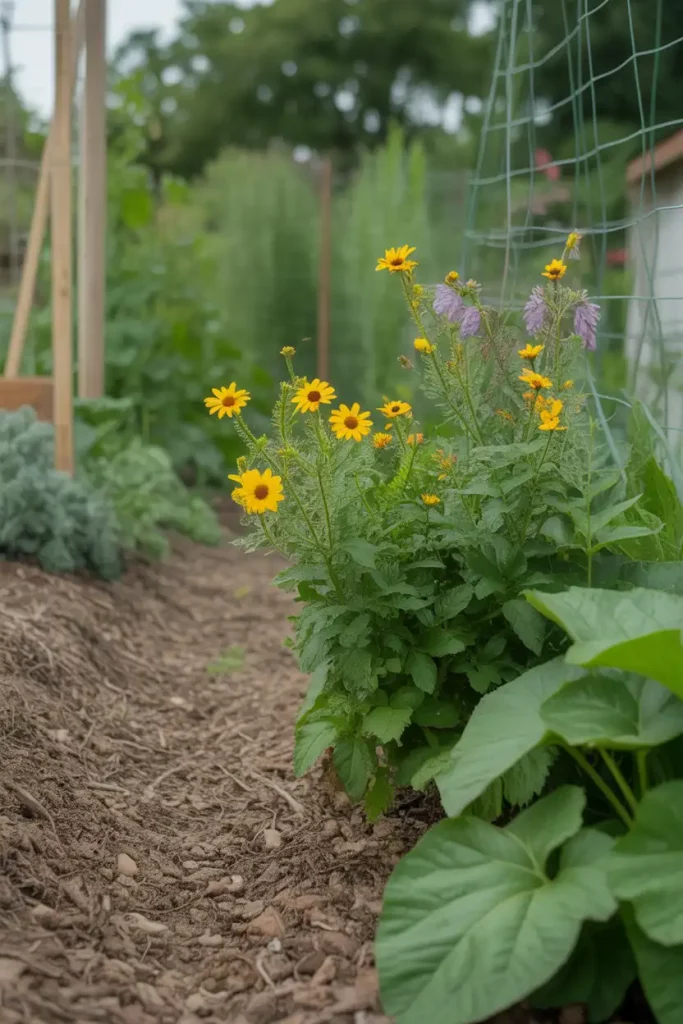
Managing garden pests through natural methods maintains cottage garden health while preserving beneficial insects and garden ecosystem balance. I emphasize prevention and biological controls over chemical interventions that can disrupt natural relationships.
Encourage beneficial insects through diverse plantings and habitat provision rather than relying solely on pest elimination. I grow plants that attract predatory insects, provide overwintering sites for beneficials, and maintain diverse ecosystems that naturally control pest populations.
Use physical barriers and cultural practices to prevent pest problems before they develop. I employ row covers, companion planting, and proper garden hygiene to reduce pest pressure while maintaining attractive garden appearances.
Apply organic treatments judiciously when intervention becomes necessary, choosing methods that target specific problems while minimizing impact on beneficial garden inhabitants. I research treatment options carefully and apply them precisely rather than broadcasting broadly.
41. Cottage Garden Microclimate Management
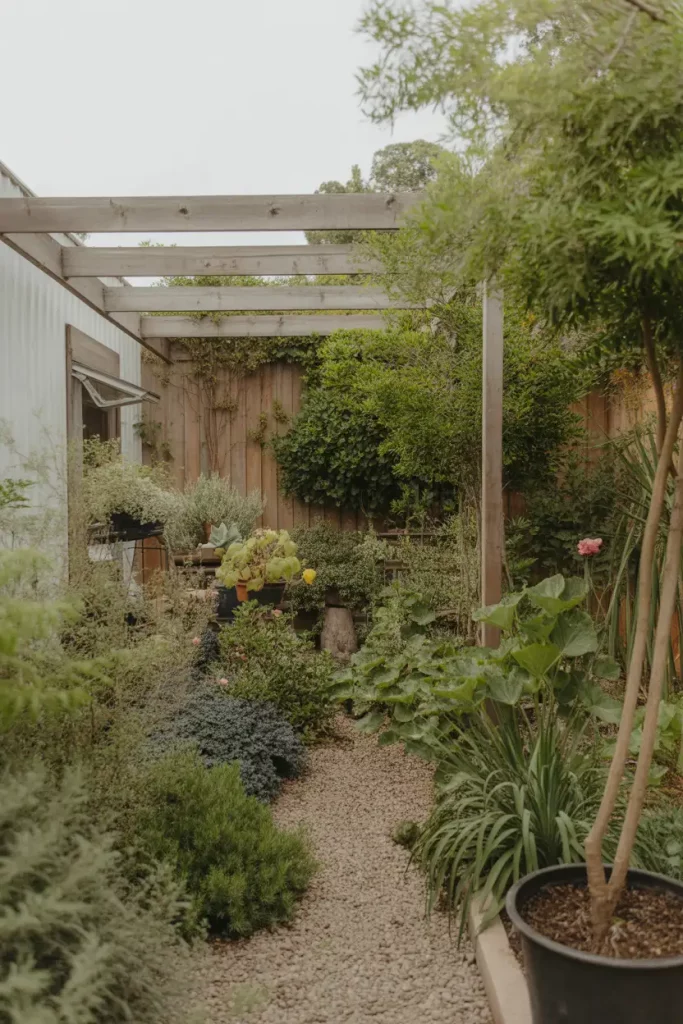
Understanding and managing garden microclimates allows successful cultivation of plants that might otherwise struggle in your general climate zone. I observe and modify growing conditions to expand plant possibilities while working with natural site characteristics.
Identify existing microclimates within your garden space by observing sun patterns, wind exposure, moisture levels, and temperature variations throughout the day and season. I map these variations and choose plants accordingly while modifying conditions where beneficial.
Create beneficial microclimates through strategic placement of structures, plants, and garden features. I use walls, fences, and large plants to provide shelter, improve drainage in wet areas, and capture heat for tender plants.
Monitor microclimate conditions regularly and adjust management strategies based on seasonal changes and plant responses. I keep records of successes and failures, learning from experience to improve microclimate management over time.
42. Cottage Garden Photography
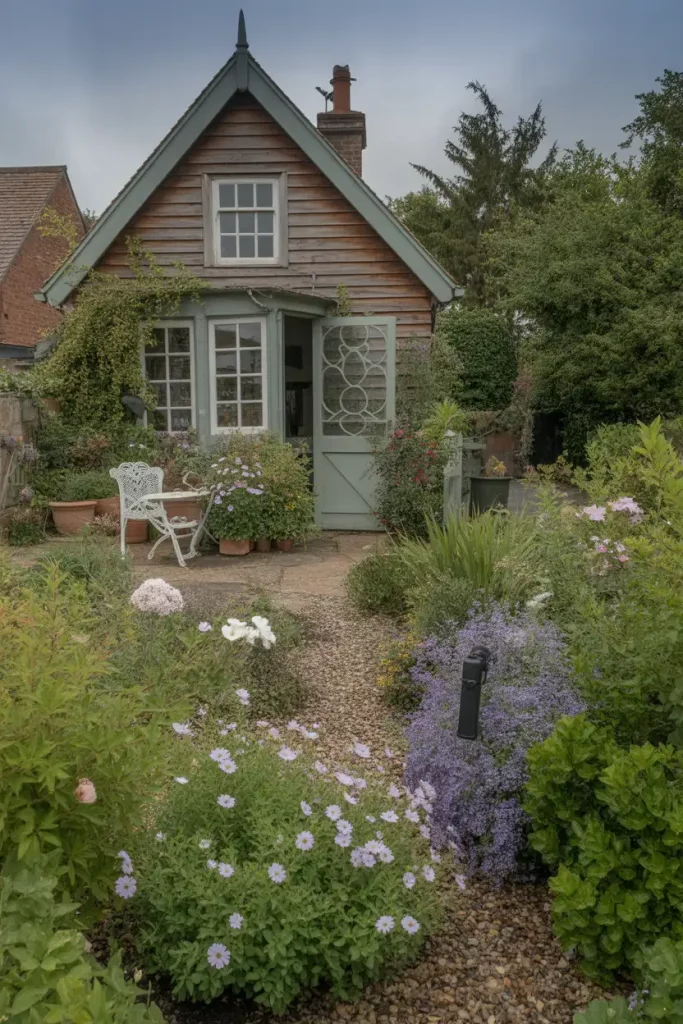
Documenting cottage gardens through photography preserves memories while providing valuable records for planning and improvement. I photograph gardens regularly, capturing both overall views and intimate details that showcase garden development over time.
Photograph gardens at different times of day and in various weather conditions to capture their full character and beauty. I take pictures in morning and evening light, after rain showers, and during different seasons to document changing moods and appearances.
Focus on both wide shots that show garden structure and close-ups that capture plant details and combinations. I document successful plant partnerships, seasonal highlights, and garden problems to inform future planning and improvements.
Use garden photography as a planning tool by reviewing images to identify areas needing improvement, successful combinations worth repeating, and seasonal gaps requiring attention. I study photos during winter months to plan coming season improvements.
43. Cottage Garden Community Building
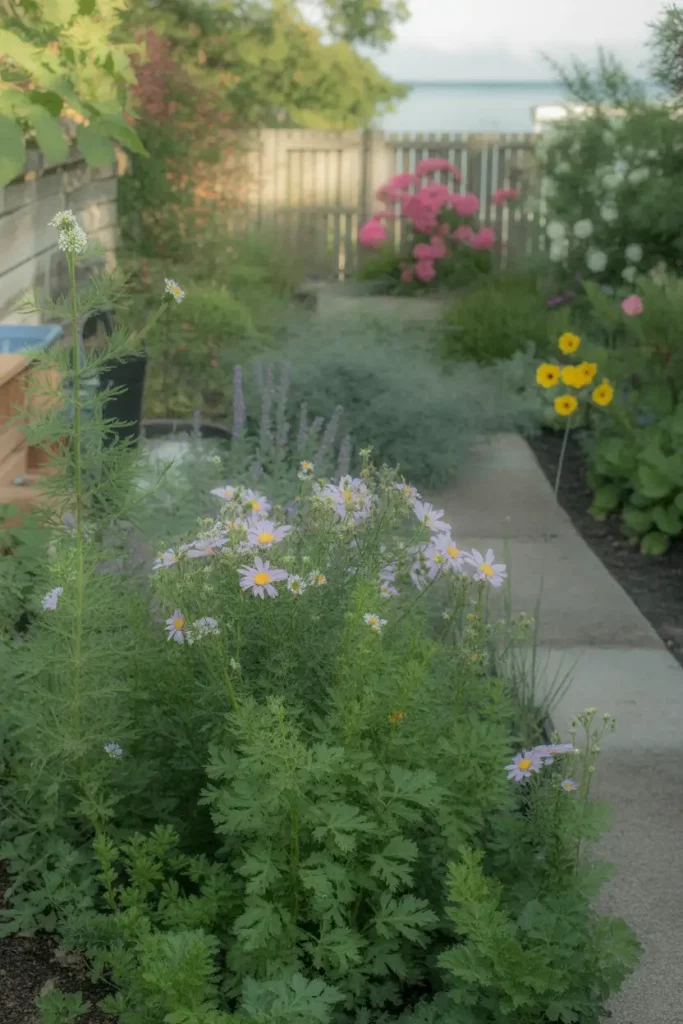
Sharing cottage gardens with others builds community connections while spreading knowledge and enthusiasm for this gardening style. I participate in garden tours, plant swaps, and educational events that connect like-minded gardeners and promote cottage gardening.
Open gardens to visitors through formal tours or informal sharing with neighbors and friends. I enjoy showing others through my garden, discussing plant choices and design decisions while learning from their observations and experiences.
Participate in plant exchanges and seed swaps that build gardening community while providing access to unusual varieties. I contribute plants and seeds while acquiring new varieties, building relationships with fellow gardeners through shared interests.
Share knowledge through teaching, writing, or mentoring other gardeners who want to create cottage gardens. I volunteer with garden clubs, write about gardening experiences, and help beginning gardeners develop skills and confidence.
44. Cottage Garden Legacy Planning
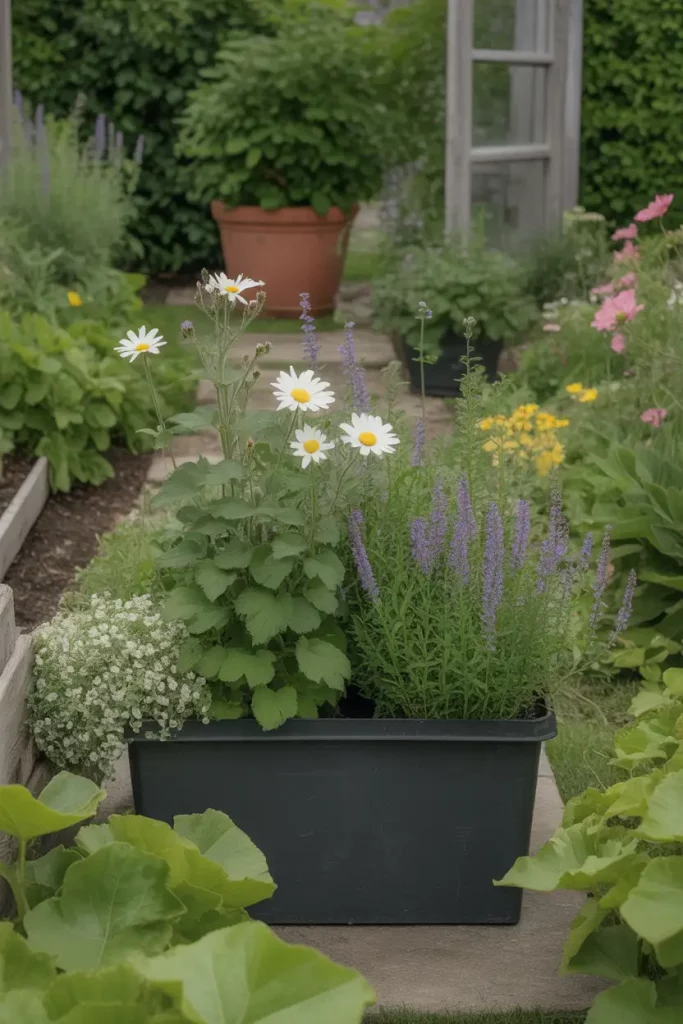
Planning for garden continuity ensures cottage gardens survive and thrive beyond their original creators. I document garden history, preserve important plants, and plan for future caretakers who will continue garden development.
Create detailed garden records that document plant locations, varieties, sources, and care requirements for future reference. I maintain planting maps, care schedules, and supplier information that help others understand and maintain garden elements.
Preserve important plant varieties through seed saving, propagation, and sharing with other gardeners who can maintain stocks. I ensure rare or sentimental plants survive through multiple locations and caretakers rather than depending on single gardens.
Train family members or other potential caretakers in garden care techniques and philosophy, sharing knowledge that enables continuity of garden character and plant health. I involve others in garden activities while explaining underlying principles and reasoning.
See also: 10 Inspiring Home Office Nook Ideas for Small Spaces in 2025
45. Cottage Garden Personal Expression
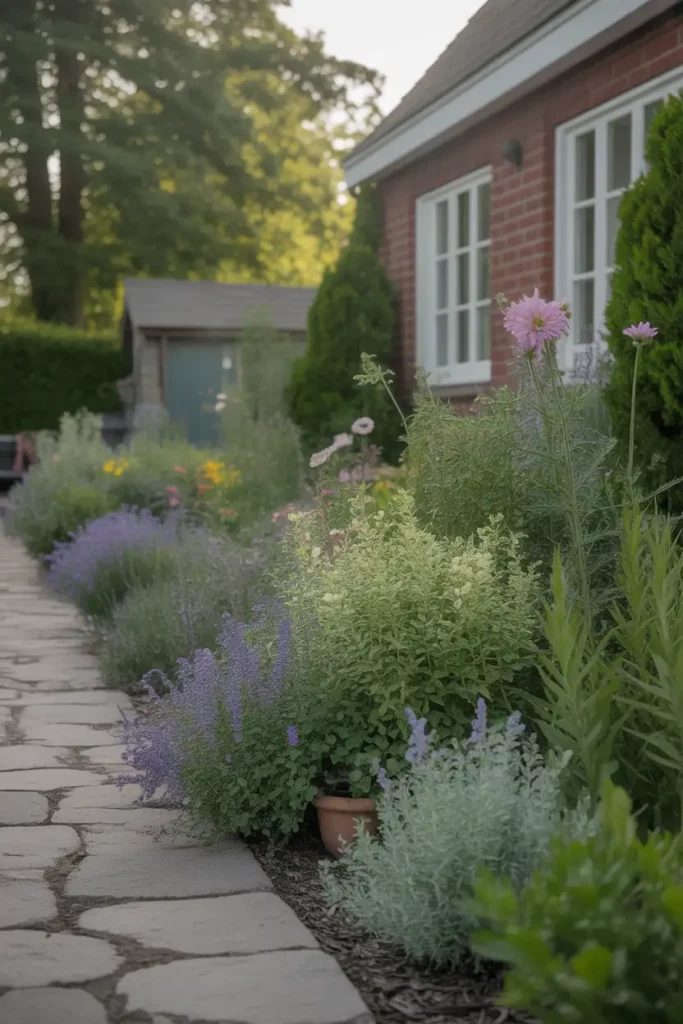
Ultimately, cottage gardens succeed through personal expression and individual creativity that reflects their creators’ personalities and preferences. I encourage gardeners to adapt cottage garden principles to their own situations, tastes, and local conditions rather than copying rigid formulas.
Develop garden styles that reflect personal interests, cultural backgrounds, and aesthetic preferences while maintaining cottage garden spirit. I incorporate elements that have personal meaning while staying true to cottage garden principles of abundance, informality, and mixed plantings.
Experiment with plant combinations, color schemes, and design elements that appeal to individual tastes rather than following prescribed rules. I try new ideas each season, keeping successful innovations while discarding approaches that don’t work or don’t bring joy.
Trust personal instincts and preferences when making garden decisions, remembering that successful cottage gardens reflect their creators’ personalities and bring personal satisfaction. I make choices based on what appeals to me while remaining open to learning and growth through experience.
Conclusion
These small cottage garden ideas have transformed my approach to gardening and can do the same for you, regardless of your space limitations or experience level. Creating a cottage garden isn’t about following strict rules or achieving perfection – it’s about embracing the joy of abundance, mixing practical with beautiful, and letting your personality shine through plant choices and design decisions.
The magic of cottage gardening lies in its forgiving nature and endless possibilities for creativity. Every garden will be different because every gardener brings unique perspectives, preferences, and local conditions to their outdoor space. What matters most is starting with enthusiasm and allowing your garden to evolve naturally over time.
I hope these 45 ideas inspire you to begin or enhance your own cottage garden journey. Remember that the most beautiful gardens develop gradually through seasons of experimentation, learning, and growth. Don’t feel pressured to implement everything at once – choose ideas that excite you most and build from there.
Start small, dream big, and trust the process. Your cottage garden will reward your efforts with beauty, fragrance, food, and endless opportunities for peaceful moments in nature. The plants, wildlife, and visitors who discover your garden will all benefit from the love and creativity you invest in this timeless gardening style.
Happy gardening, and may your cottage garden bring you years of joy, satisfaction, and connection to the natural world right outside your door.

